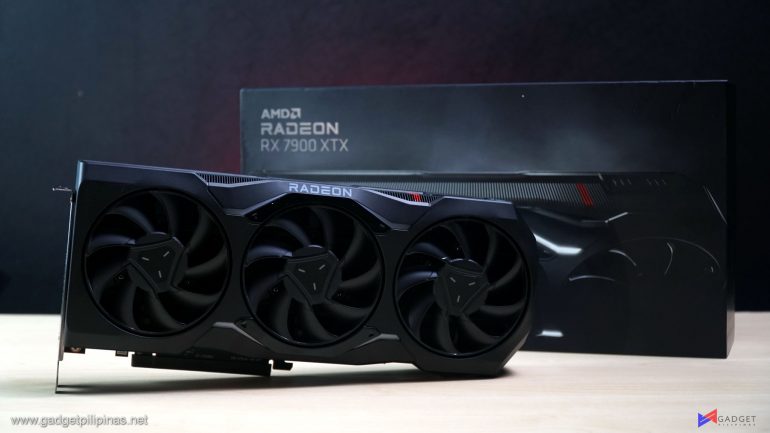All eyes are on AMD as the brand launches its RX 7900 series graphics cards built under the RDNA3 Architecture, the world’s first chiplet-style GPU architecture design similar to AMD Ryzen CPUs. The new RDNA3 Architecture enables the RX 7900 XTX and RX 7900 XT to compete directly with Nvidia’s RTX 4080 while being priced significantly lower. We’ll take a look at the RX 7900 XTX in this review to see whether or not AMD’s aggressive pricing will pay off.
AMD RDNA 3 Architecture
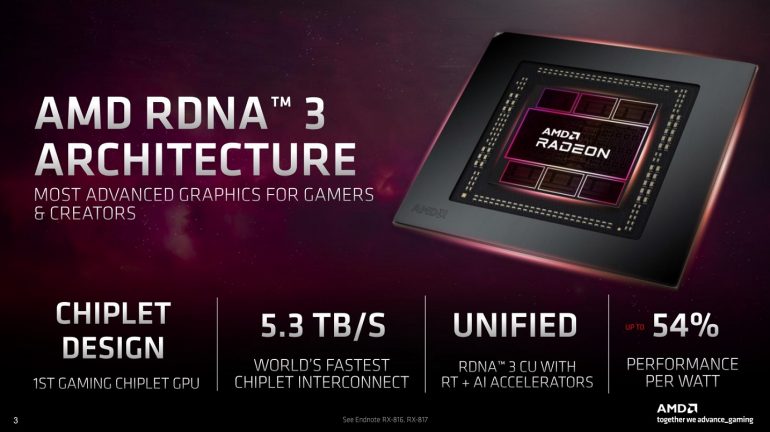
AMD implements a chiplet-style design on its RDNA 3-powered graphics cards making them similar to the latest AMD Ryzen CPUs. Like its Ryzen counterparts, RDNA3 GPUs have a 5nm Graphics Compute Die and a 6nm Memory Cache Die. These two dies have a 5.3TB/s interconnect, making it the fastest chiplet interconnect available to date.
AMD Radiance Display Engine and Dual Media Engine
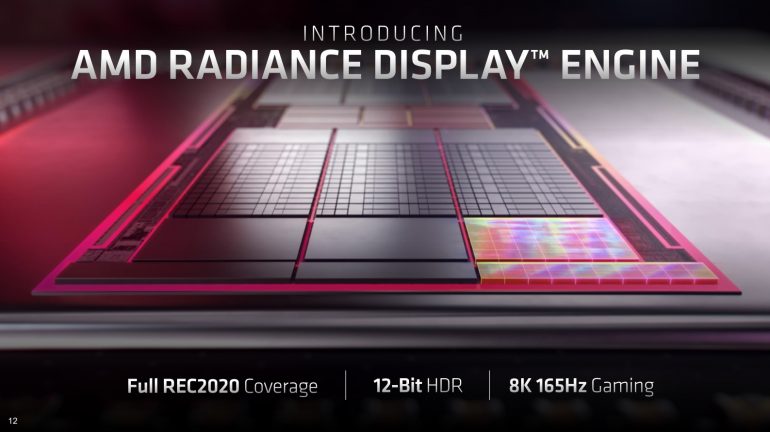
AMD RX 7900 Series graphics cards are the first set of GPUs to utilize the DisplayPort 2.1 interface. The new Radiance Display engine doubles the 54 Gbps Display Link Bandwidth per port over RDNA 2, to support maximum refresh rates of 1440p at 900Hz, 4k at 480Hz, and 8K at 165Hz. This makes the RX 7900 XTX and RX 7900 XT compatible with upcoming DisplayPort 2.1 monitors.
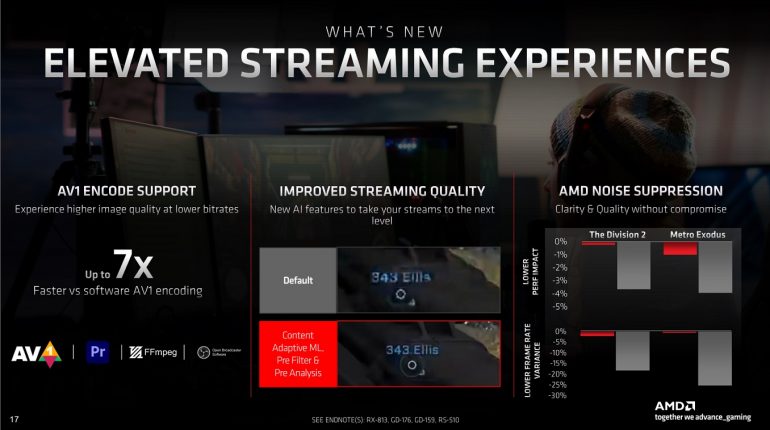
Like the latest Nvidia RTX 40 series and Intel Arc GPUs, AMD RX 7900 series GPUs also has hardware-accelerated support for AV1 thanks to the new Dual Media Engine. The new Dual Media Engine allows two simultaneous Encode or Decode streams for AVC and HEVC up to 8K60. Alongside the new Dual Media Engine is added support for more quality-of-life improvements for streamers such as AMD Noise Suppression
AMD HYPR-RX
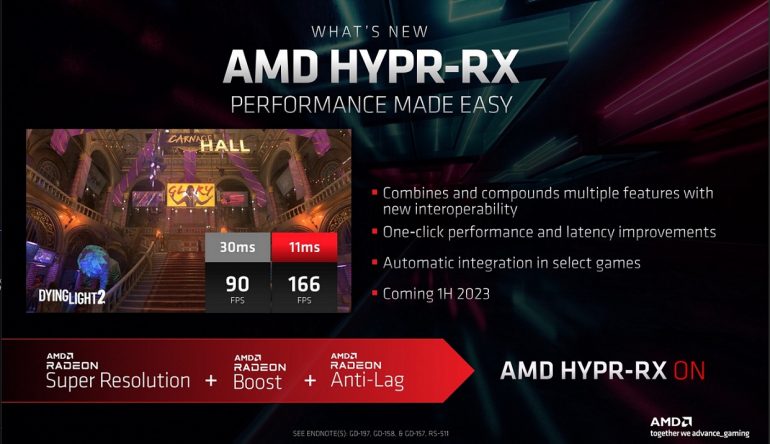
AMD Hyper-RX is a feature that we’re most excited about but unfortunately, it won’t be available until the first half of 2023. AMD Hypr-RX is a one-click solution that instantly enables AMD Super Resolution, AMD Radeon Boost, and AMD Radeon Anti-Lag providing hassle-free performance uplift and latency improvements. AMD Hyper-RX will have automatic integration in AMD-supported game titles.
AMD Radeon RX 7900 Series
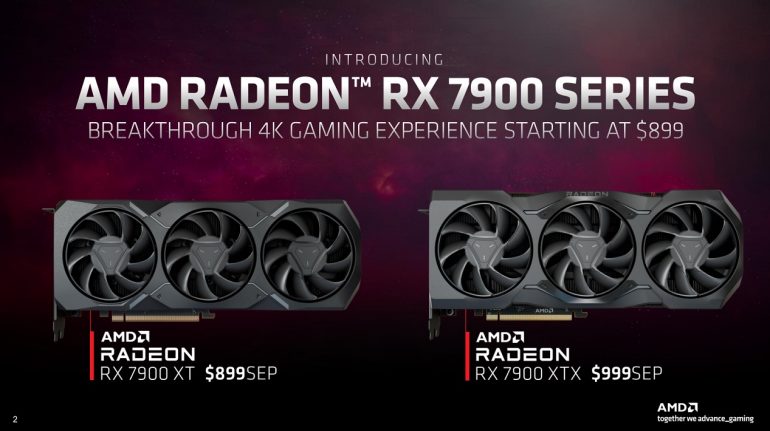
AMD introduced two new graphics cards under the RX 7900 series, the Radeon RX 7900 XT and Radeon RX 7900 XTX priced at $899 and $999 respectively. AMD stresses the 7900 series value proposition over the RTX 4080 on its together we advance_gaming event and takes a shot at Nvidia with its “Easy upgrade” presentation as users don’t have to change almost anything in their setup when upgrading to the RX 7000 series as it still sports a 2.5 slot cooler, two 8-pin PCI-E connectors, and only up to 355W of TBP.
AMD RX 7900 XTX Specs
| Radeon RX 7900 XTX | Radeon RX 7900 XT | Radeon RX 6900XT | |
| GPU | Navi 31 XTX | Navi 31 XT | Navi 21 XTX |
| Compute Units | 96 | 84 | 80 |
| Stream Processors | 6144 | 5376 | 5120 |
| Ray Accelerators | 96 | 84 | 80 |
| Texture Units | 384 | 336 | 320 |
| ROPs | 192 | 192 | 128 |
| Game Clock | 2300 MHz | 2000 MHz | 2015 MHz |
| Boost Clock | 2500 MHz | 2400 MHz | 2250 MHz |
| Memory | 24GB G6 | 20GB G6 | 16GB G6 |
| Infinity Cache | 2nd Gen 96MB | 2nd Gen 80MB | 128 MB |
| Memory Clock | 20 Gbps | 20 Gbps | 16 Gbps |
| Memory Bandwidth | 960 GB/s | 800 GB/s | 512 GB/s |
| Memory Bus | 384-bit | 320-bit | 256-bit |
| Total Board Power | 355W | 300->315W | 300W |
| Launch MSRP | $999 US | $899 US | $899 US |
The AMD Radeon RX 7900 XTX is the flagship graphics card of the RX 7000 series GPUs featuring 96 CUs, up to 2.3GHz Game Clock, and 24GB 384-bit GDDR6 in a 355W package. The RX 7900 XTX also supports AV1 Encoding and Decoding as well as the latest Display Port 2.1 output.
AMD Radeon RX 7900 XTX Unboxing and Overview
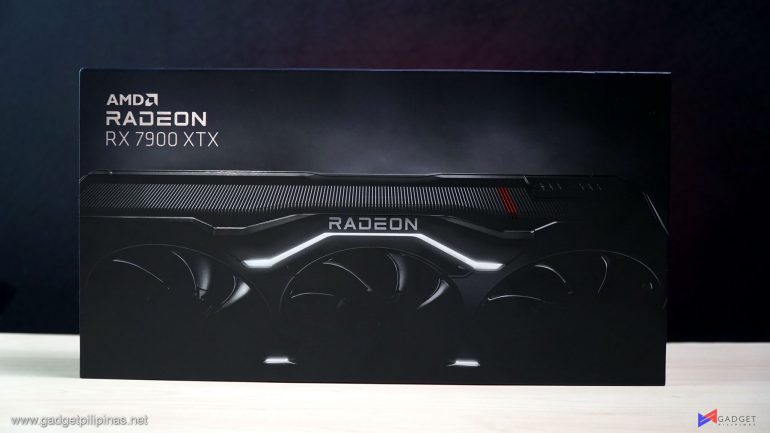
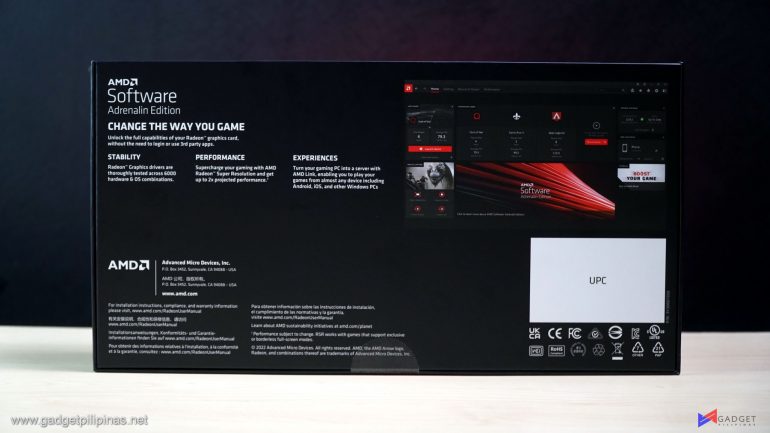
Compared to last year’s RX 6800 series packaging, the packaging for the RX 7900 XTX is less flashy and looks a bit more mature and premium with subtle text and branding as well as the preview shot of the RX 7900 XTX.
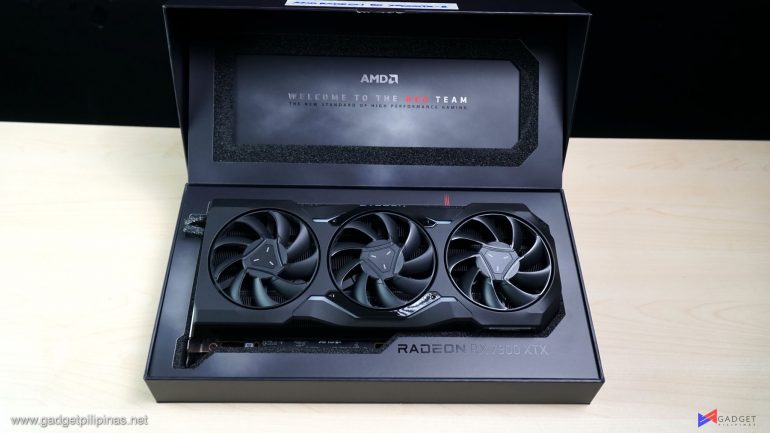
AMD never fails to provide a premium unboxing experience with its graphics cards. Upon opening the package you are greeted with the RX 7900 XTX GPU itself and the text “Welcome to the red team. The new standard of high performance gaming.”
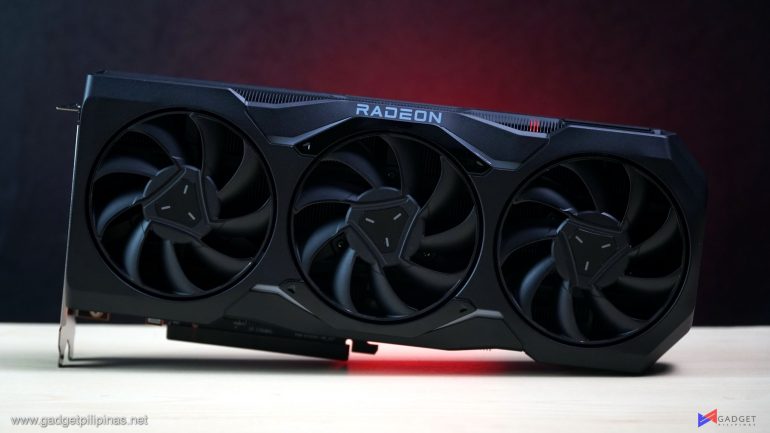
The AMD Radeon RX 7900 XTX’s cooler design is a bit of a love-hate relationship for me personally. I am in love with the matte black finish on the RX 7900 XTX as it makes it feel premium but its edgy design makes it look small and it looks excessive in personal compared to the renders. That said, the new triple fan cooler should have better cooling performance compared to the previous generation reference cards.
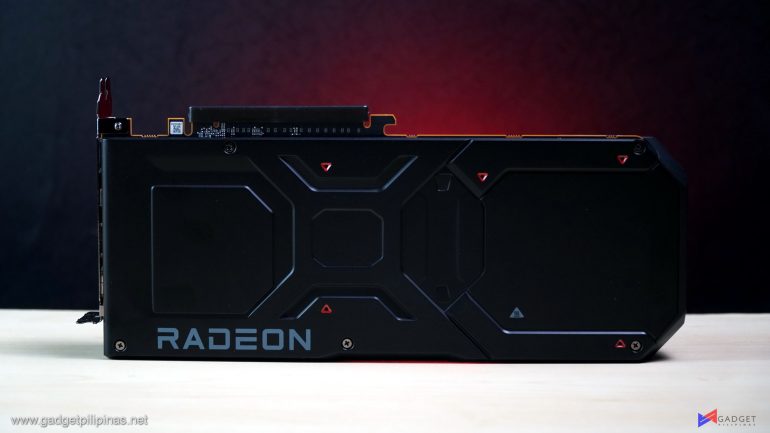
The RX 7900 XTX has a full metal backplate covering the entire length of the graphics card which not only protects the back PCB but also acts as a support bracket to reduce GPU sag. I personally am not a fan of the bumps on the back as it feels like there’s too much going on despite the plain design but the red highlights definitely add to the looks of it. The amount of red highlights is just enough that it won’t destroy your overall PC color theme.
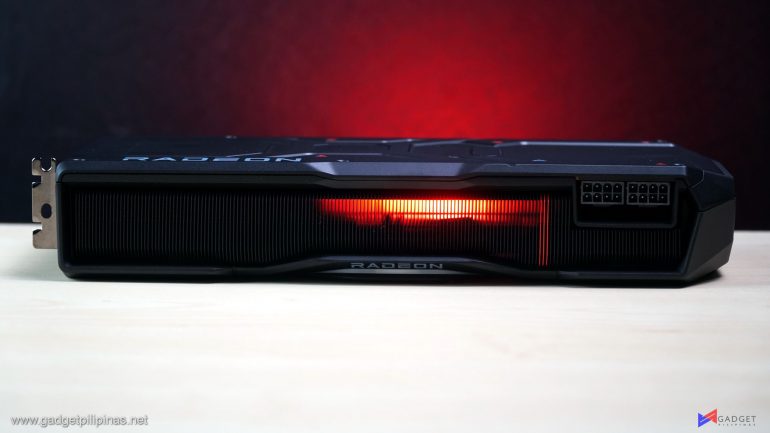
AMD has opted for a more exposed side of the RX 7900 XTX graphics card with little-to-no obstructions except for the small bump for the Radeon text to be visible on the side. This has to be the cleanest GPU side we’ve seen to date.
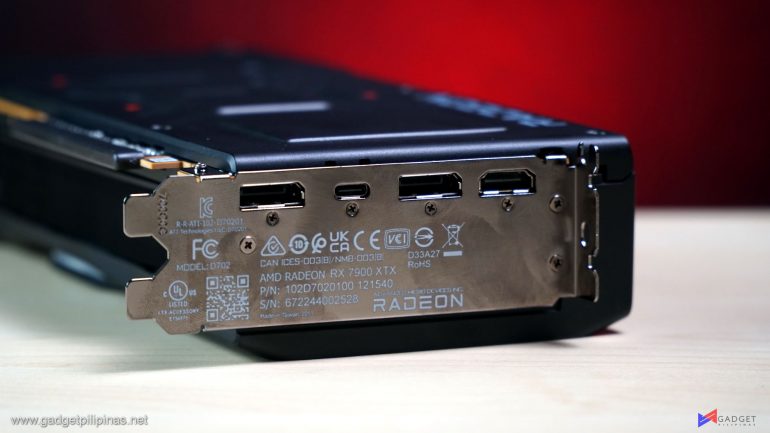
Instead of the usual three Display Port and one HDMI port combination for GPU video IO, AMD has replaced one Display Port 2.1 port with a USB-C port with support for DisplayPort over type-C. This is a double-edged move as on one hand you have extended IO thanks to the USB C port but should you use all three display ports and have older monitors, then you’d be spending extra for either a type-C to DP cable or adapter.
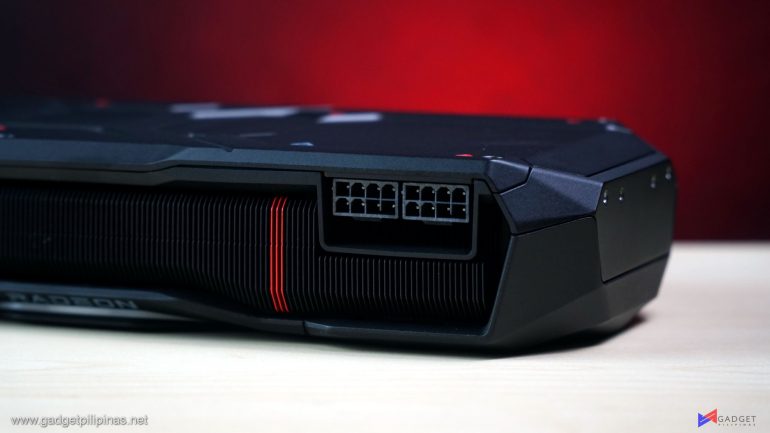
Despite having future-ready features such as Display Port 2.1 and next-gen AV1, AMD didn’t implement the infamous 12VHPWR connector on its RX 7900 Series graphics. According to AMD, this move is for gamers as it reduces their overall upgrade costs as users don’t have to upgrade their PSUs when they go for an RX 7900 Series graphics card. 12VHPWR controversy aside, kudos to AMD for prioritizing gamers.
The Radeon RX 7900 XTX has a rated TGP of 355W with a minimum recommended power supply of 800 watts. To power the graphics card, the RX 7900 XTX requires two 8pin PCI-E connectors. Compared to the RTX 4080, the 7900 XTX has a 35W higher TGP and 50W higher recommended PSU. The higher power requirement could be attributed to the 7900 XTX having more memory than the RTX 4080.
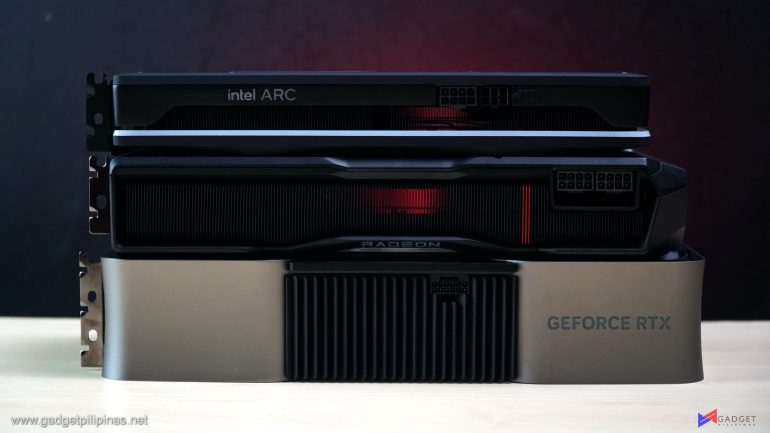
Despite having higher power requirements over the RTX 4080, the RX 7900 XTX has a smaller form factor of 2.5slot size and 287mm board length compared to the RTX 4080’s 3-slot size and 304mm length. The RX 7900 XTX is a heaven-sent for ITX PC builders looking to get their hands on a next-gen graphics card.
Test Bench Setup and Benchmark Methodology
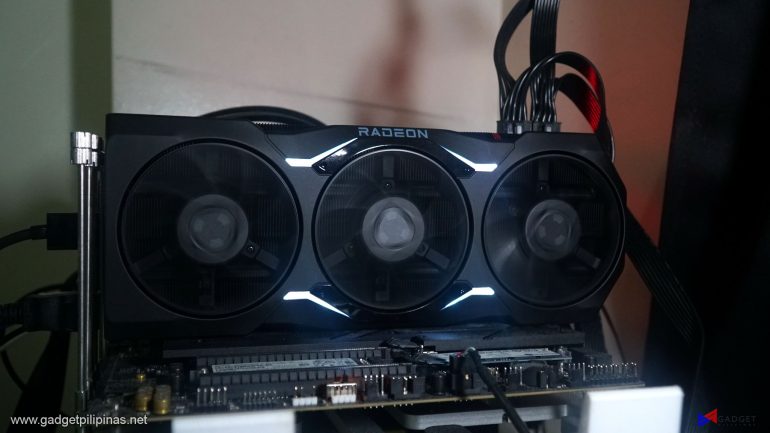
Gadget Pilipinas’ testing philosophy is to provide detail-oriented results as accurately as possible so that our readers can replicate our tests given that these conditions are met. Different benchmarking apps and sequences are used depending on the component or device being tested.
AMD Radeon RX 7900 XTX Testbench Specs
| CPU | Intel Core i9 13900K |
| COOLER | ASUS ROG RYUJIN II 360mm V2 – Noctua NT-H2 Thermal Paste |
| MOTHERBOARD | Gigabyte Z790 Aorus Master |
| MEMORY | Kingston Fury Beast RGB 32GB(2x16GB) 6000 MHz DDR5 |
| GPU | Nvidia RTX 4090 FE | Colorful iGame RTX 4090 Vulcan OC-V | RTX 4080 FE | ASUS TUF RTX 4080 | 526.72 driver | AMD Radeon RX 7900 XTX |
| STORAGE | Kingston KC3000 1TB PCI-E Gen 4 SSD |
| POWERSUPPLY | ROG Thor 1000W Platinum II PSU |
| OPERATING SYSTEM | Windows 11 Pro Build 22H2 |
| DISPLAY | Lenovo Legion Y27Q Gaming Monitor |
We use CapFrameX 1.7.0 Stable as our primary FPS capture and analysis tool for all our gaming benchmarks. The latest build version of Windows 11 Pro and WHQL-certified drivers are used for our benchmarks. Readings such as temperatures and power draw are recorded using HWINFO64, and other relevant software for cross-checking.
AMD Radeon RX 7900 XTX Benchmarks
COUNTER-STRIKE: GLOBAL OFFENSIVE
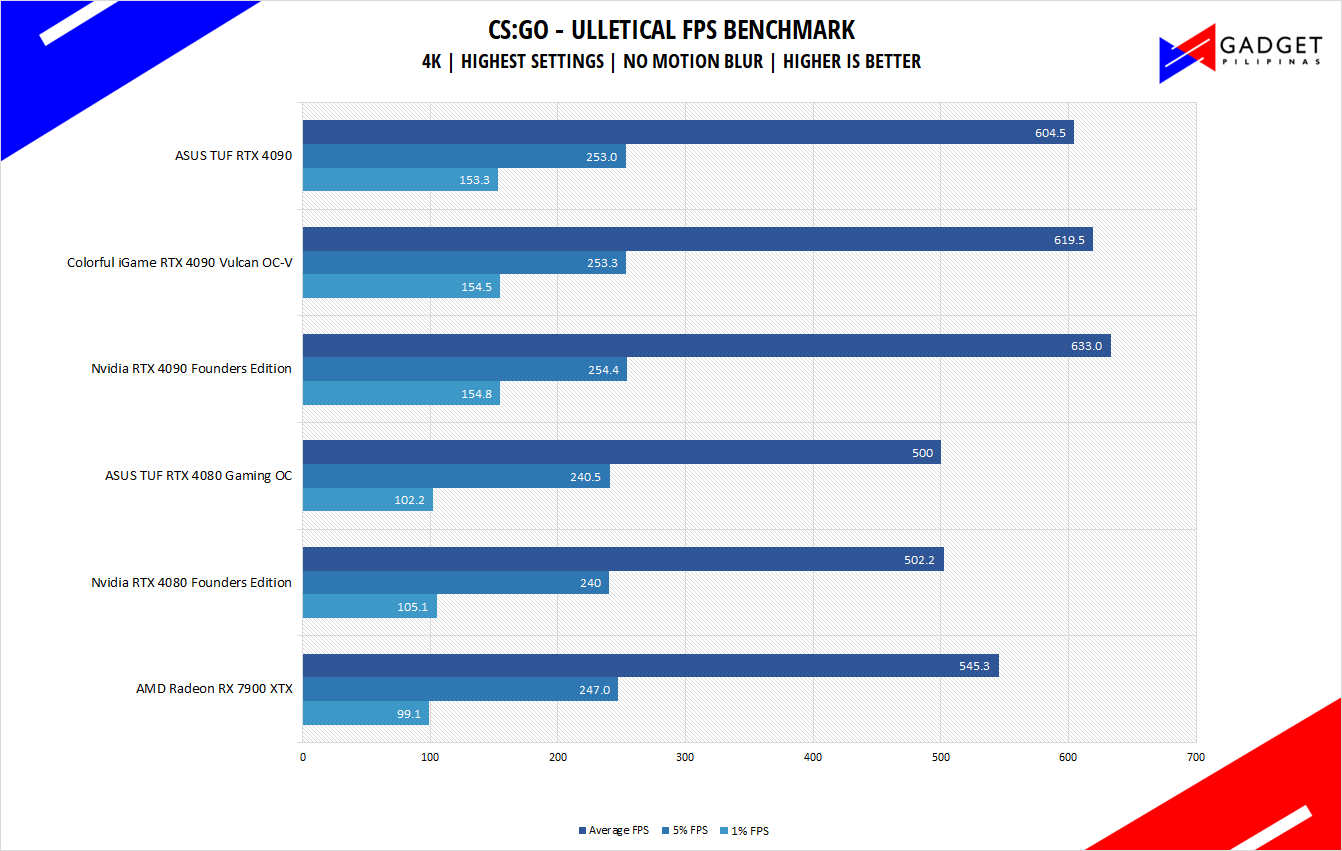
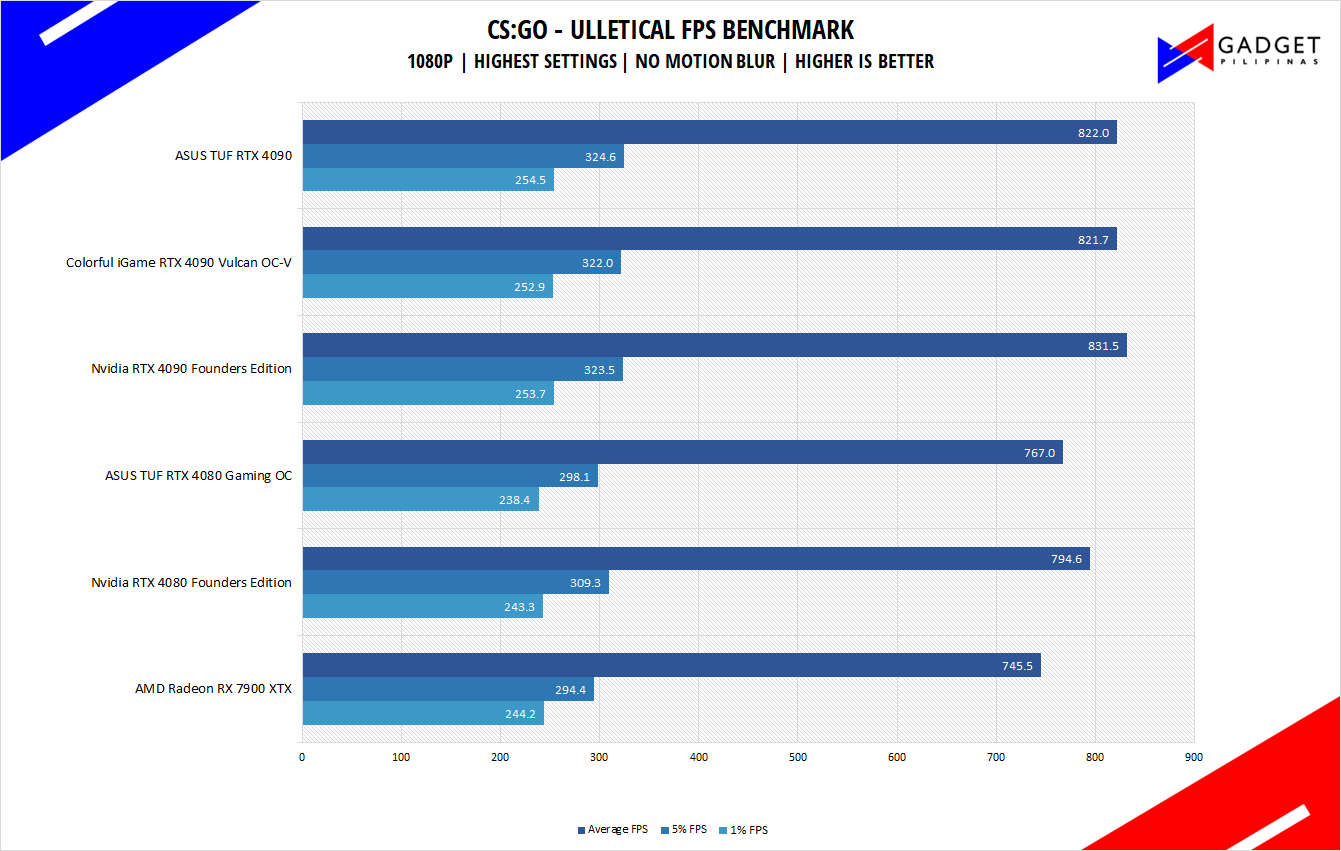
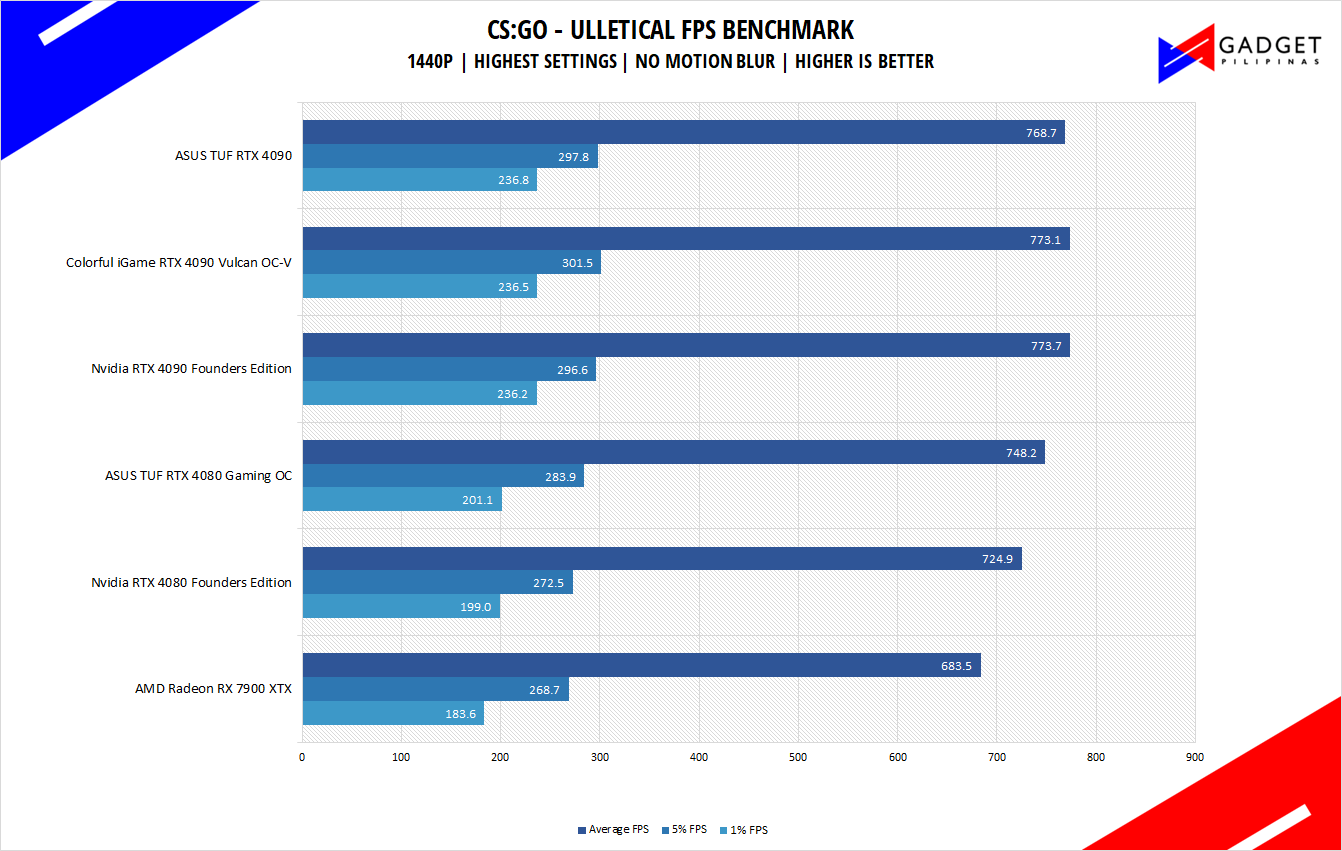
Counter-Strike: Global Offensive aka CSGO is an 11-year-old first-person shooter title that’s still widely popular despite its old Source Engine. CS:GO is a great game to test out CPU performance as the game is heavily CPU-dependent like any other FPS title. Our CS:GO benchmark process uses ULLETICAL’s FPS Benchmark workshop mod to measure the hardware’s performance.
DOTA 2

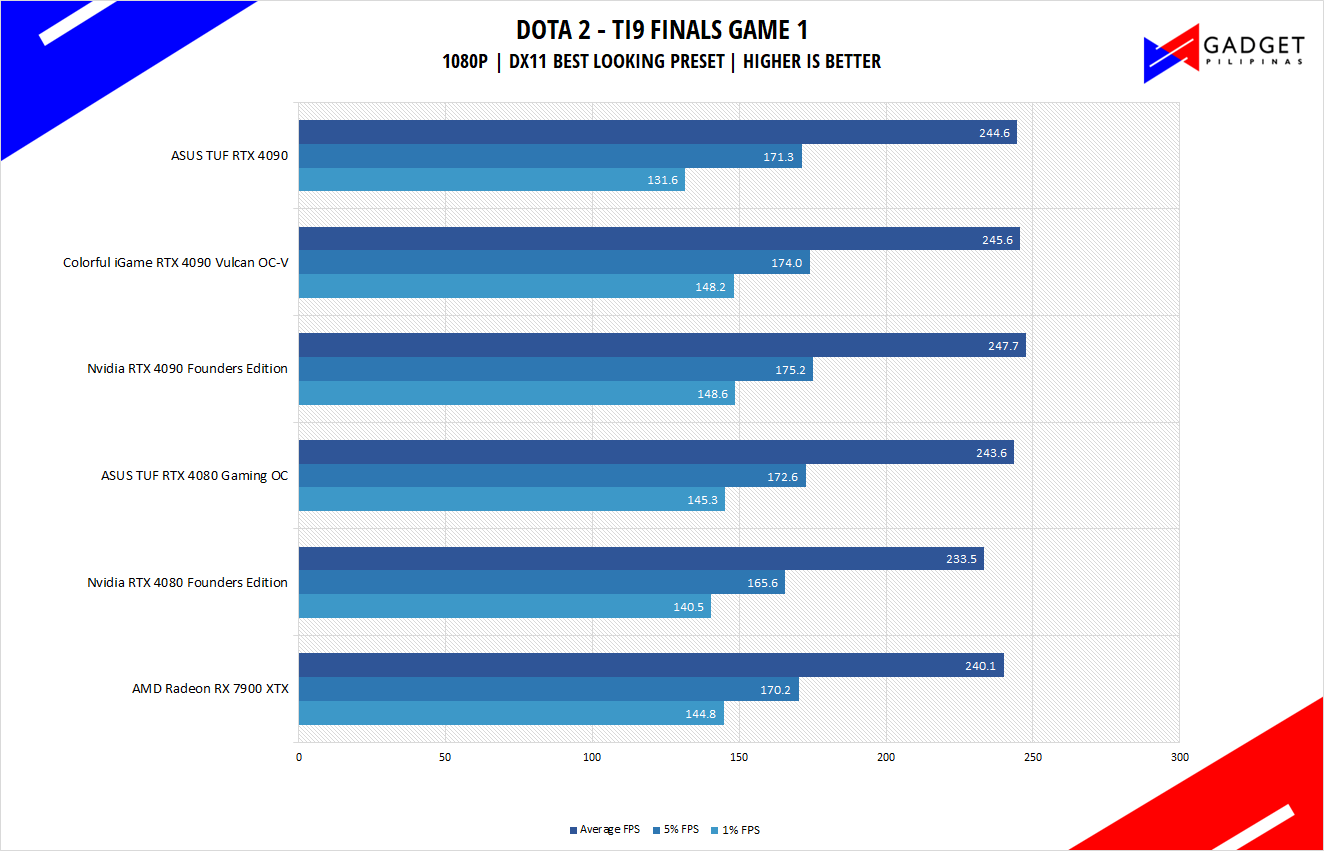
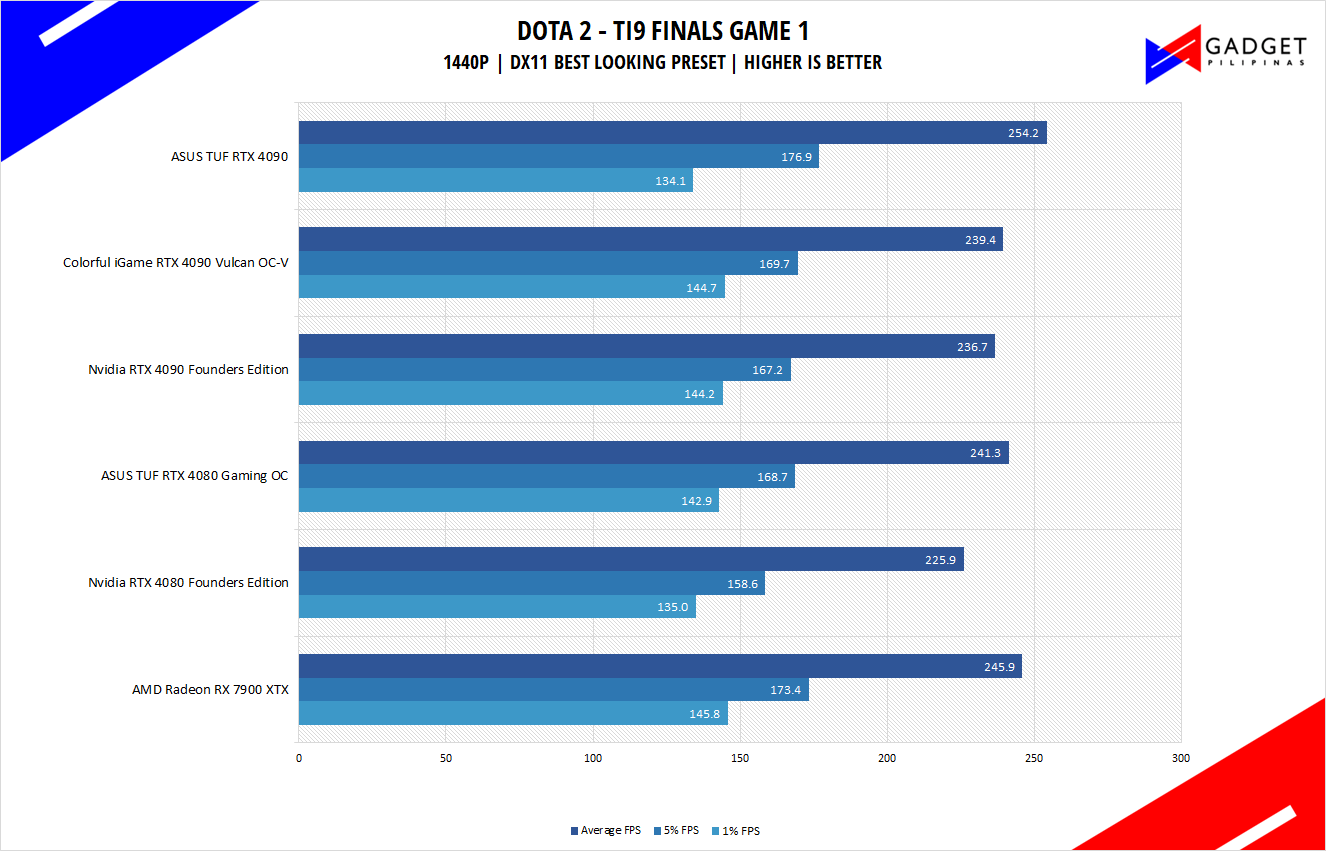
Most gamers play at least one of the following free-to-play titles: League of Legends, CS: GO, Dota 2, and/or Fortnite. Dota 2 is a good representation of the F2P titles as it is the most demanding game in the spectrum. The benchmark will give you an idea of the graphic card’s relative performance on other lesser demanding titles. Our benchmark sequence is based on a replay of OG vs. Liquid in the TI9 grand finals from the team fight that happened from 28:30 to 29:30.
Far Cry 5 & Far Cry 6
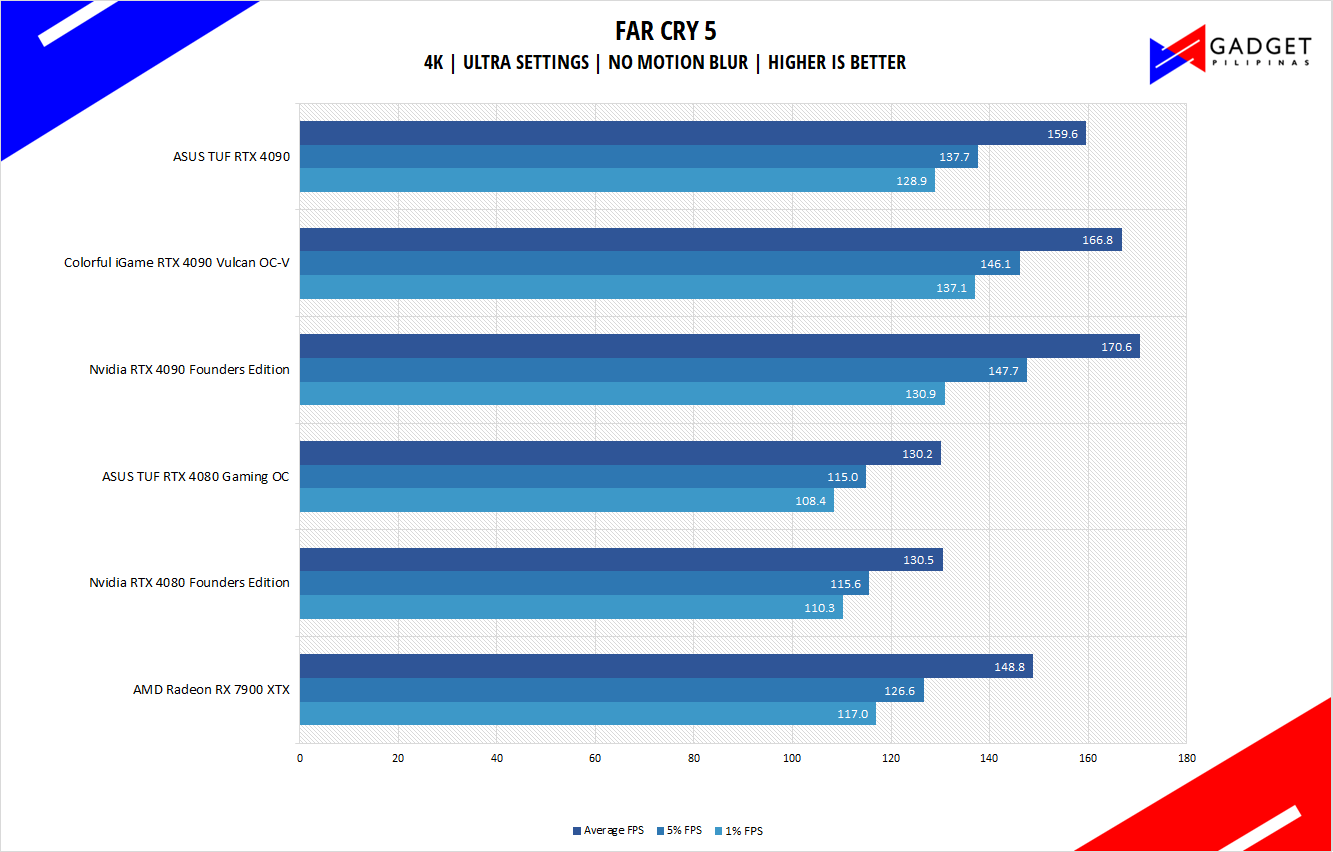
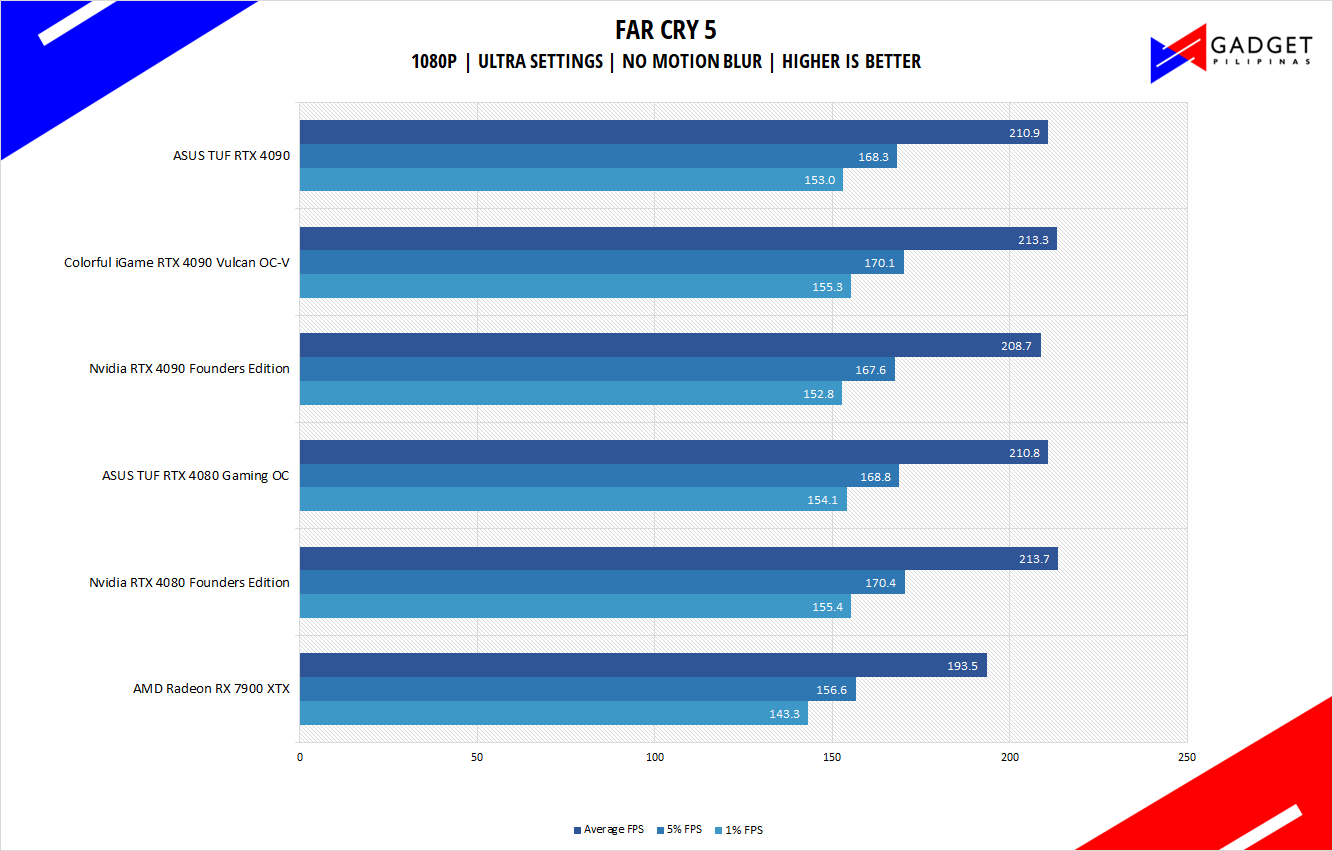
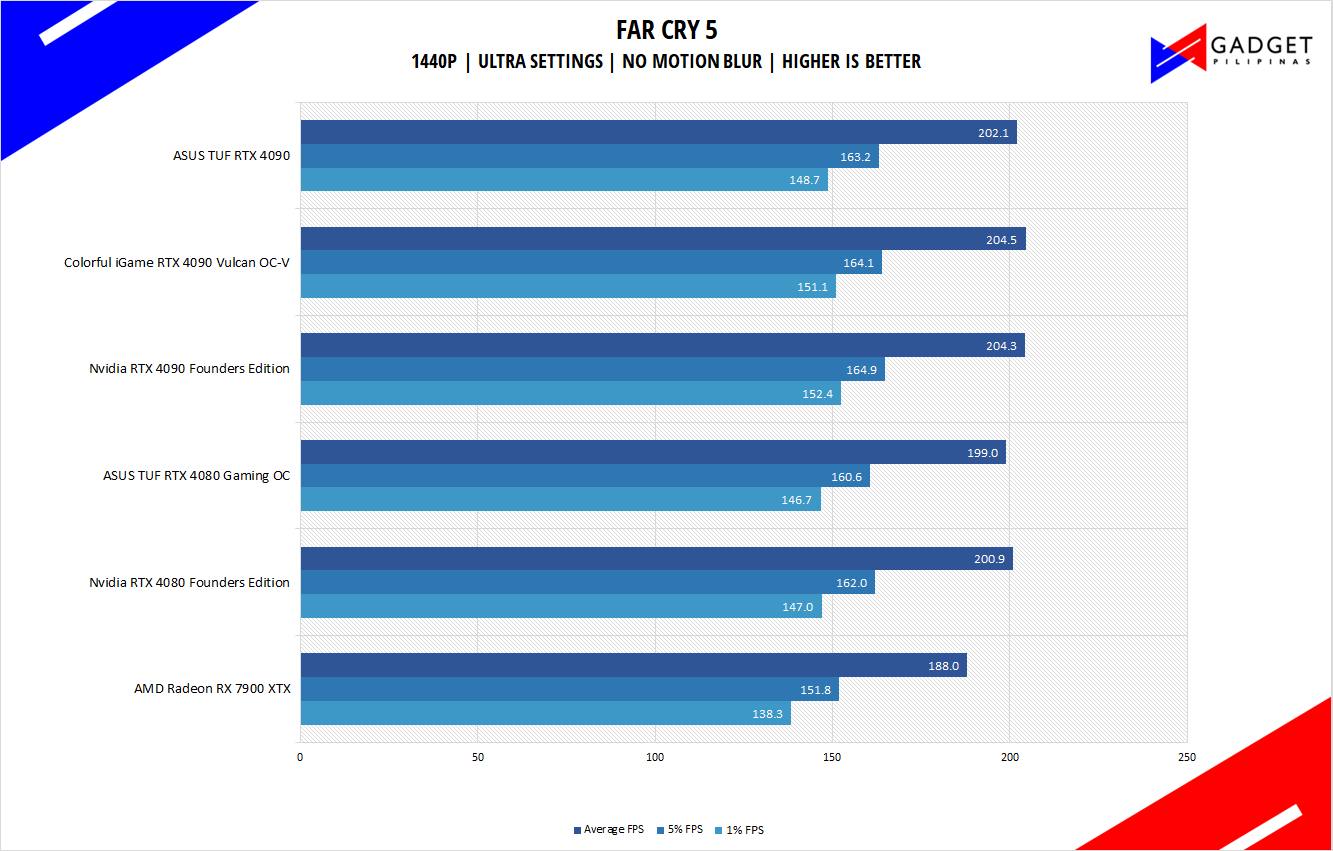
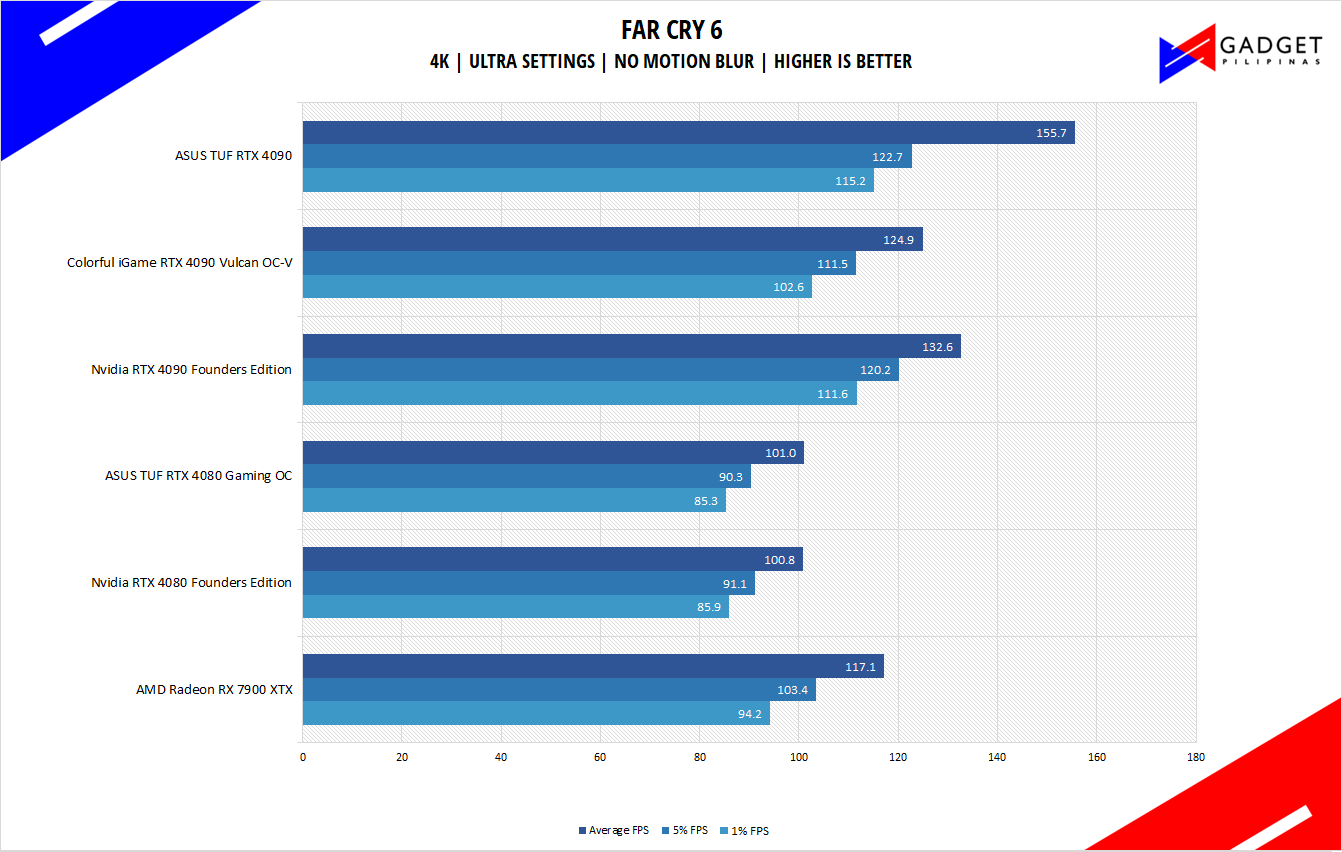
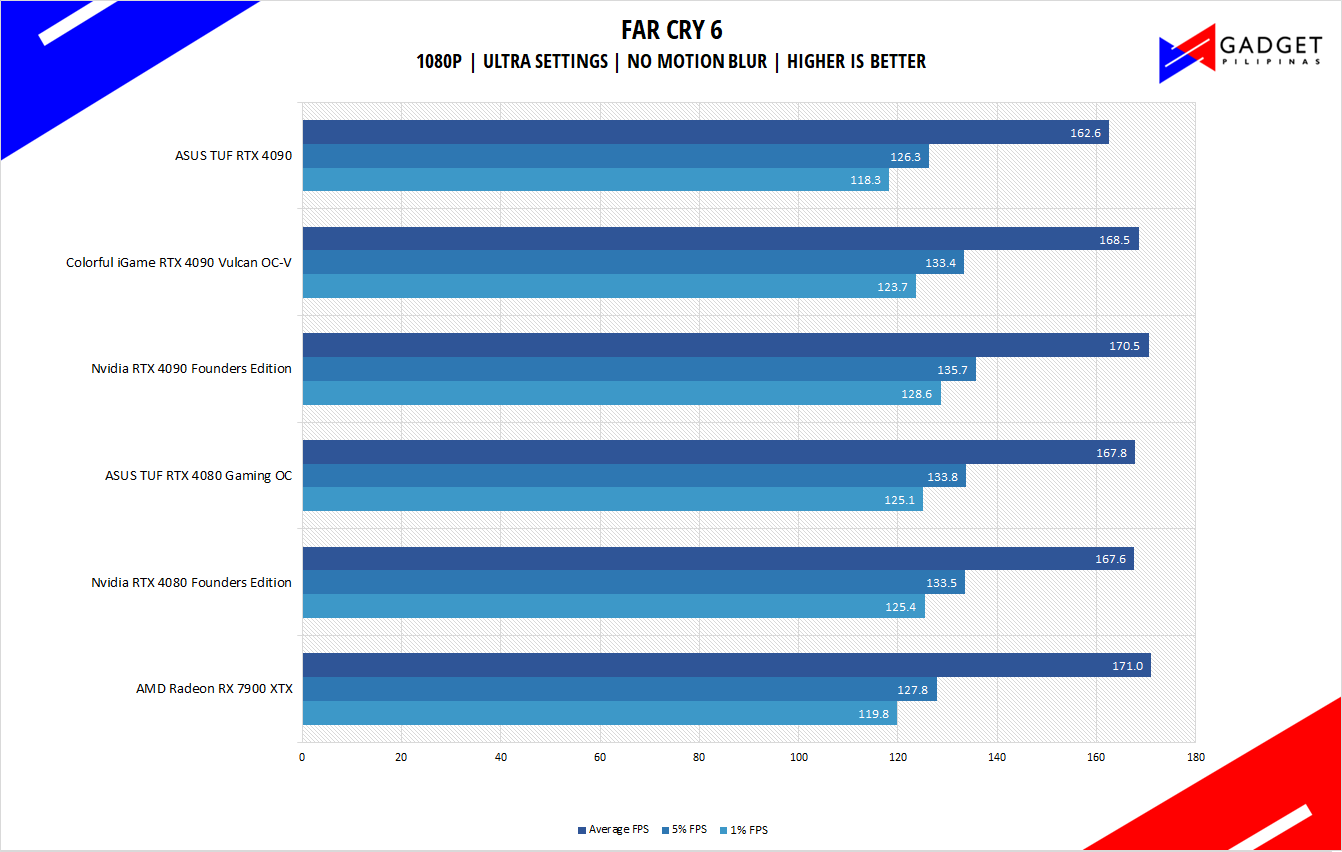
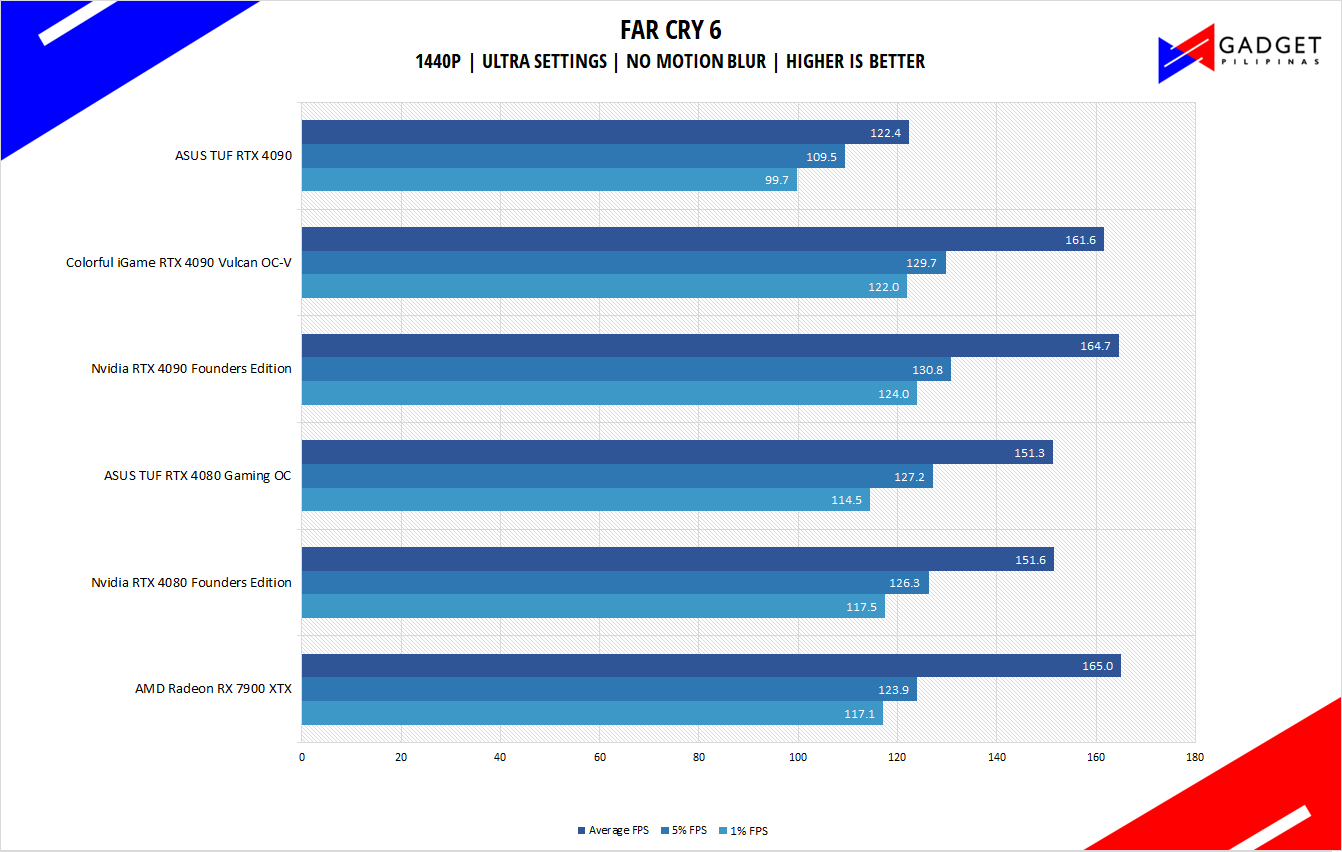
FarCry 5 is an FPS game published by Ubisoft and uses the Dunia engine. It heavily relies on and takes advantage of DirectX 11 to render a realistic environment that makes it taxing to both the CPU and GPU. Far Cry 6 is the latest installment in the franchise which utilizes DirectX 12 to run the virtual world of Yara.
Rainbow Six Siege

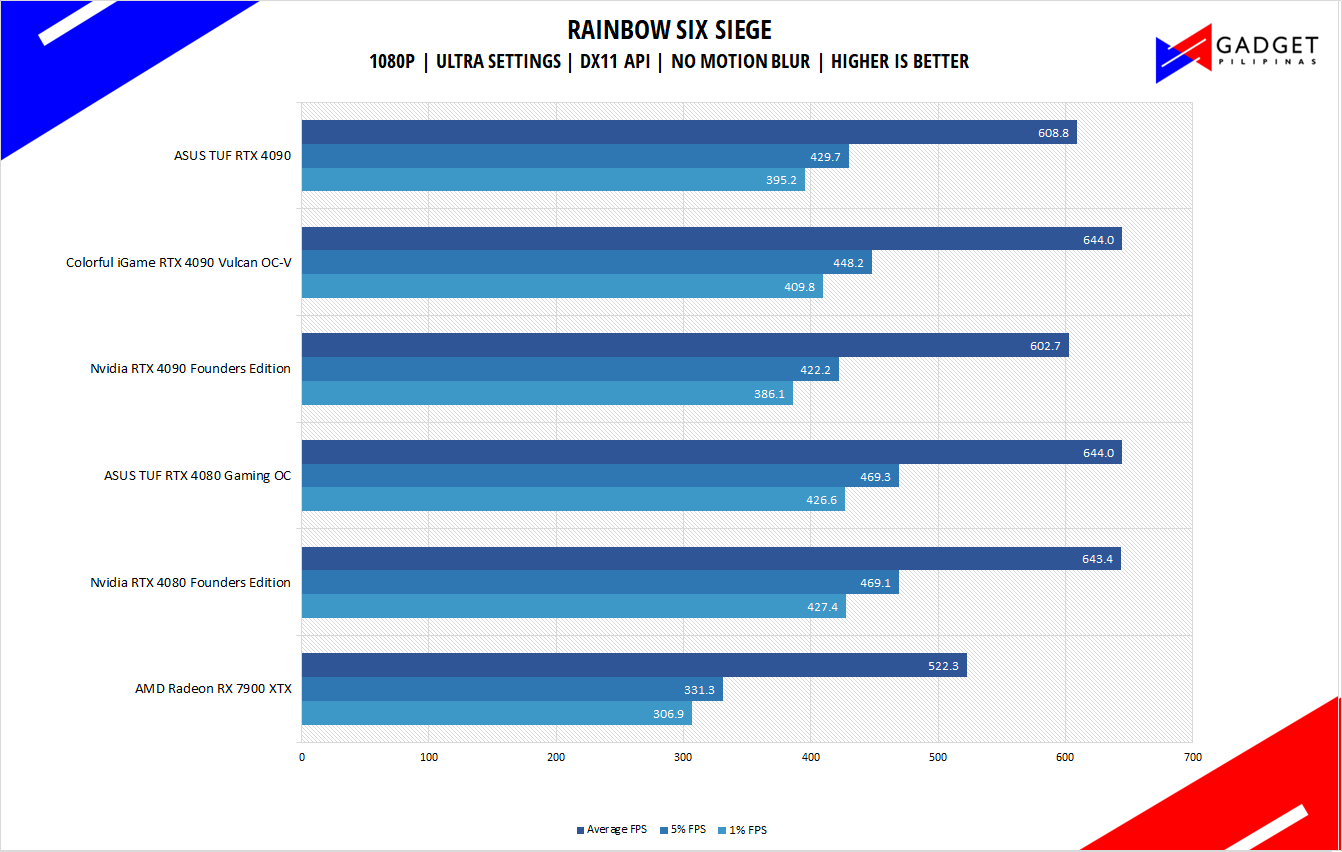
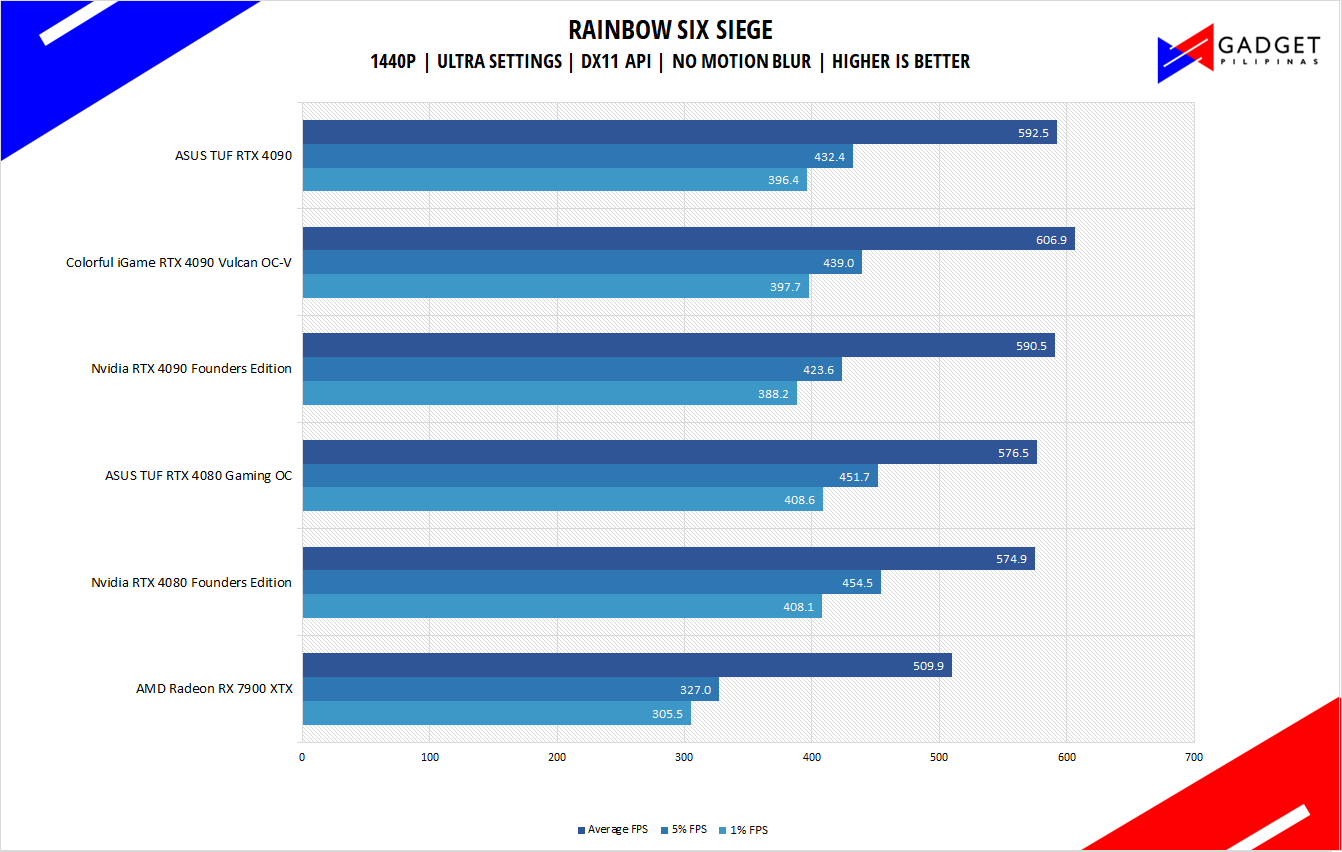
Rainbow Six Seige is one of the few popular AAA games that’s still popular in 2021 due to its competitive gameplay mechanics. R6S uses the AnvilNext game engine, which the game’s publisher, Ubisoft, developed. As of writing, Rainbow Six Siege is currently the most popular Tom Clancy title beating out Wildlands, Breakpoint, and even Division 2.
Cyberpunk 2077
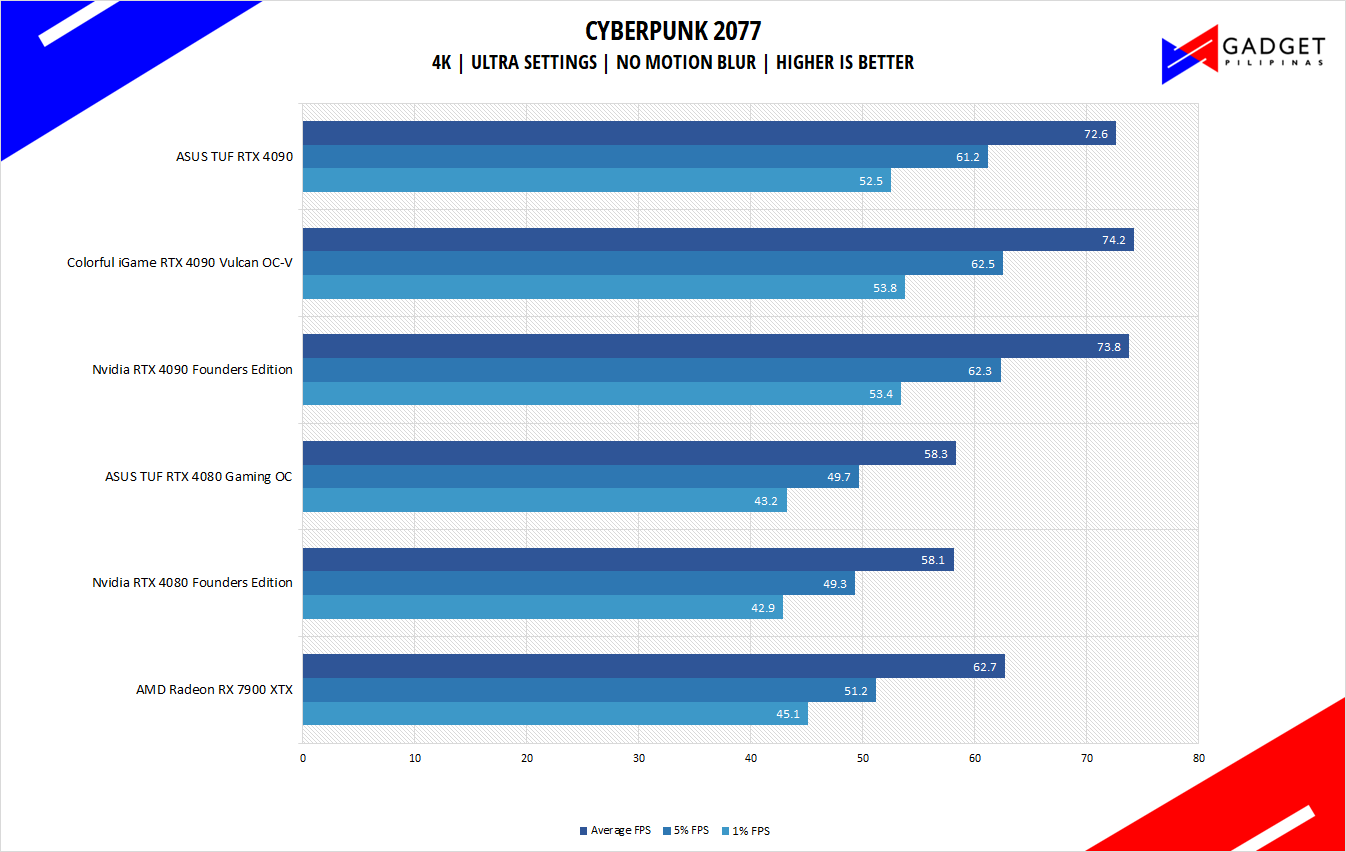
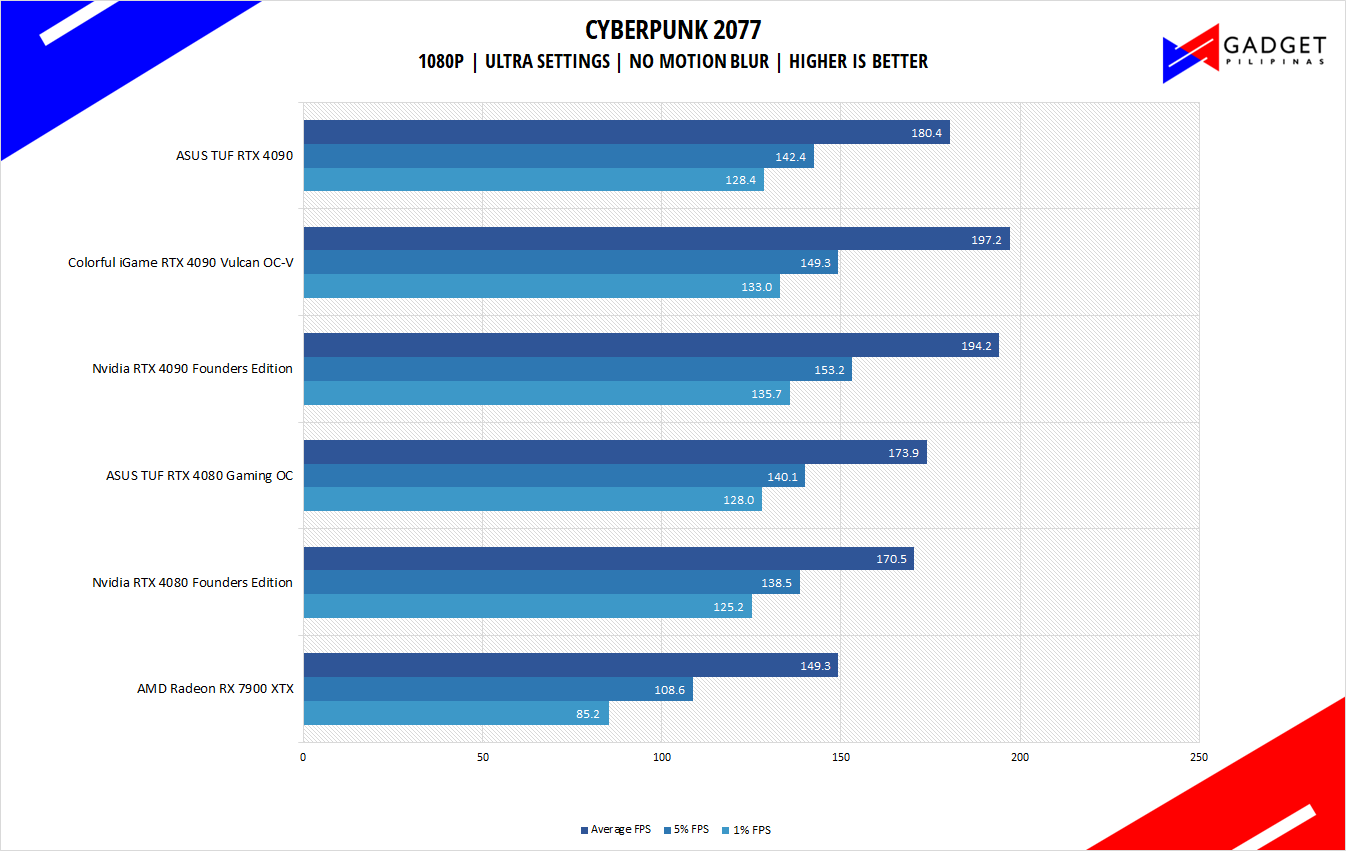
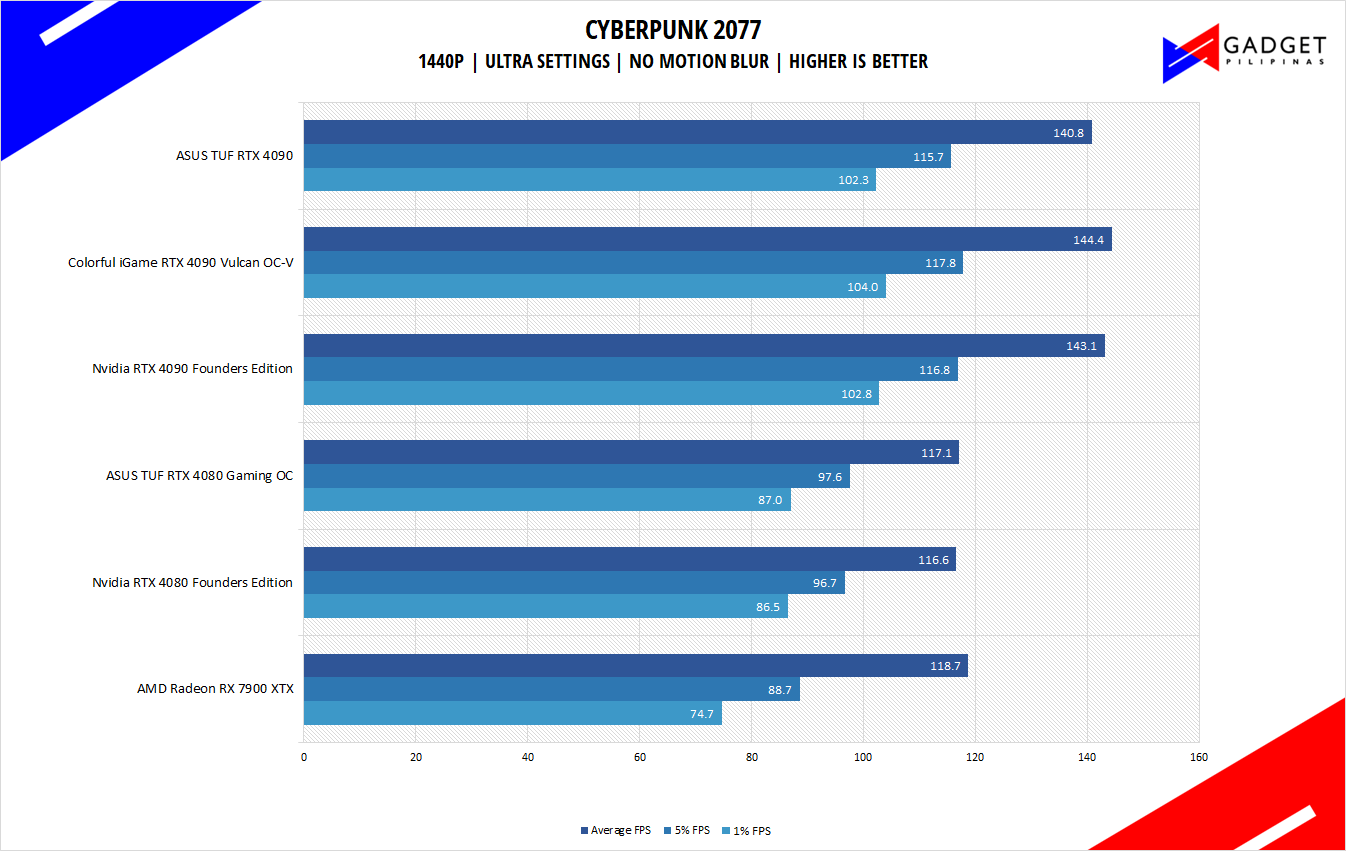
Cyberpunk 2077 is arguably the most hyped game of 2020. Developed by CD Projekt Red, the dystopian open-world, action-adventure RPG sports is one of the most demanding titles to date. Cyberpunk 2077 also supports three Ray Tracing settings as well as DLSS which makes the game a great tool to measure Ray tracing performance for both AMD and Nvidia graphics cards.
Shadow of The Tomb Raider
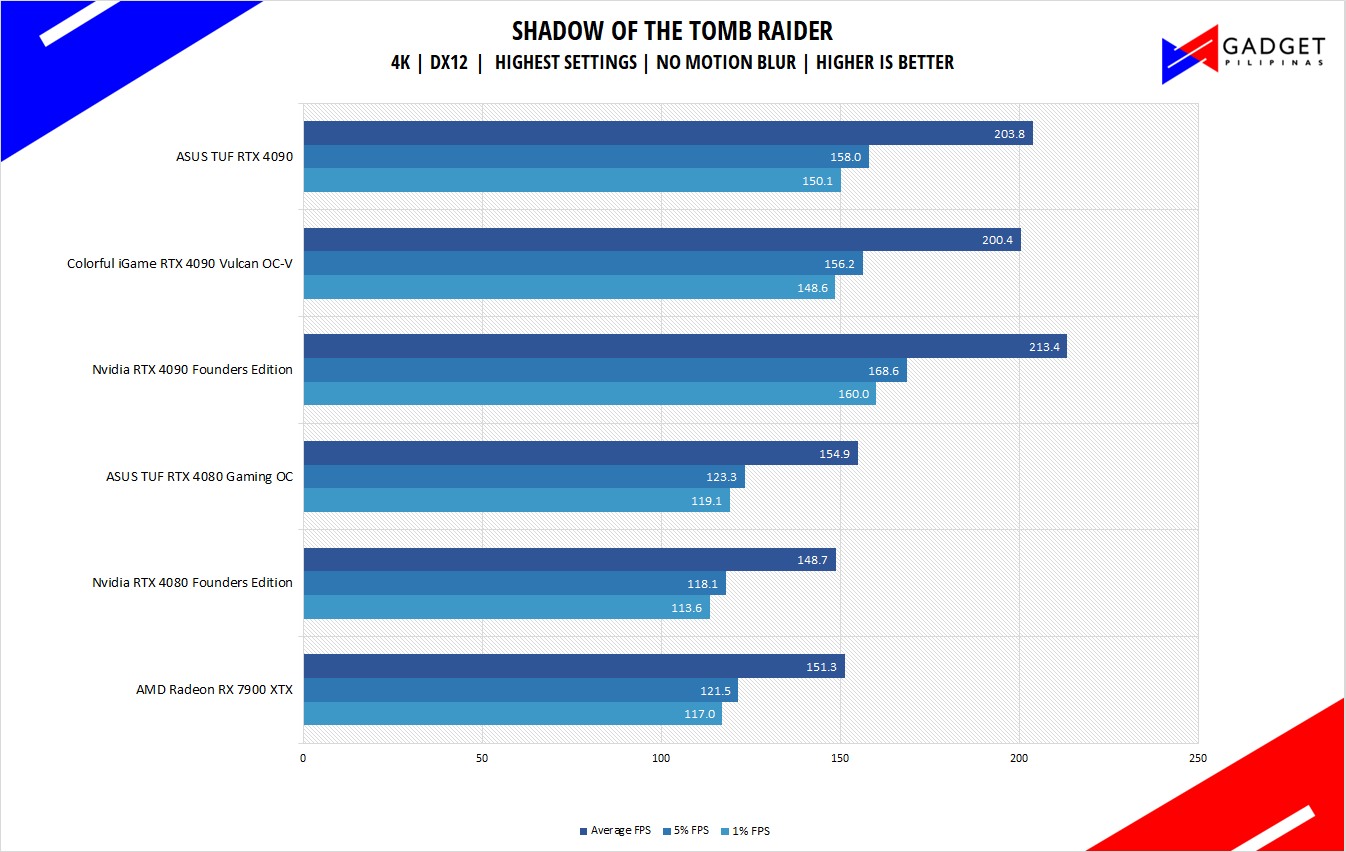
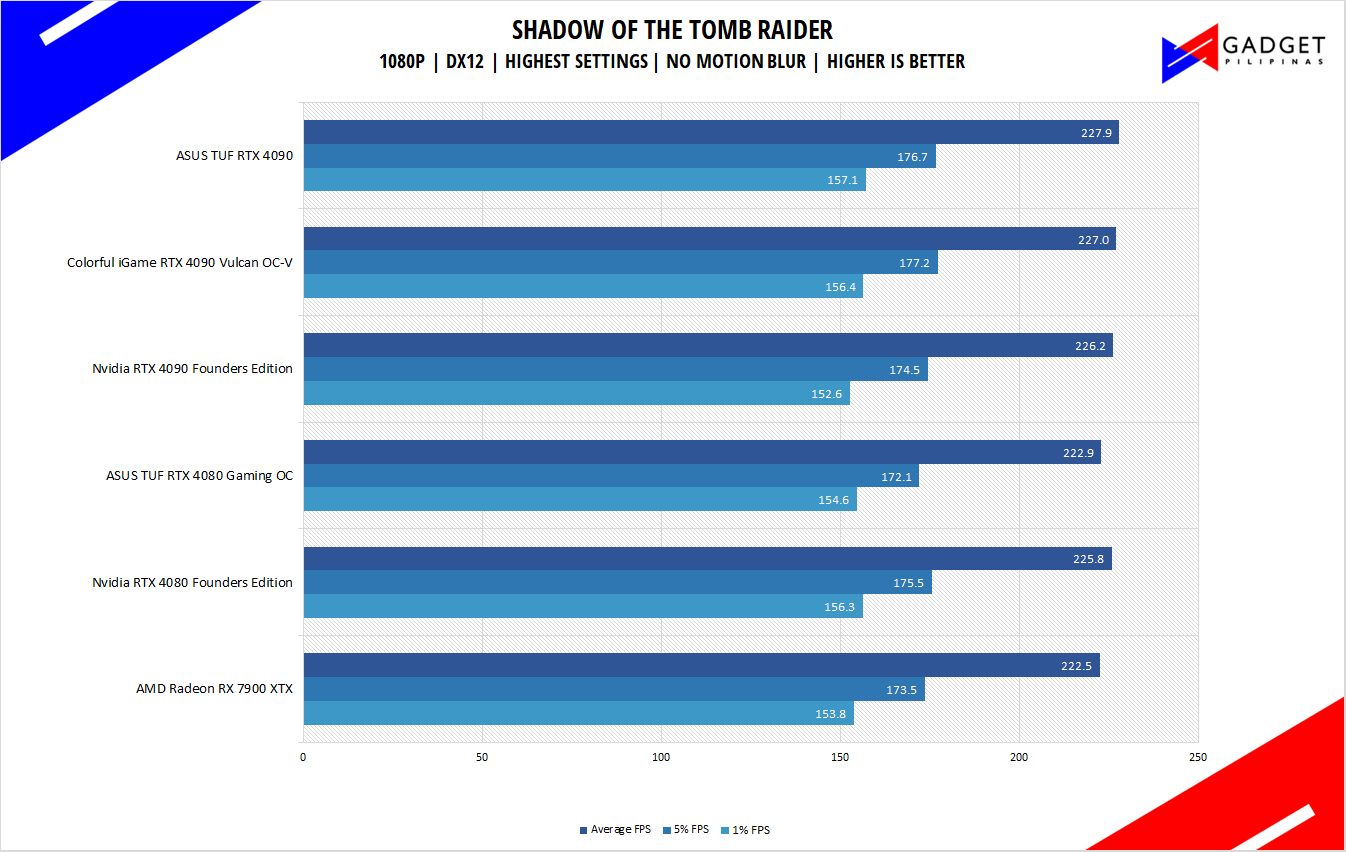
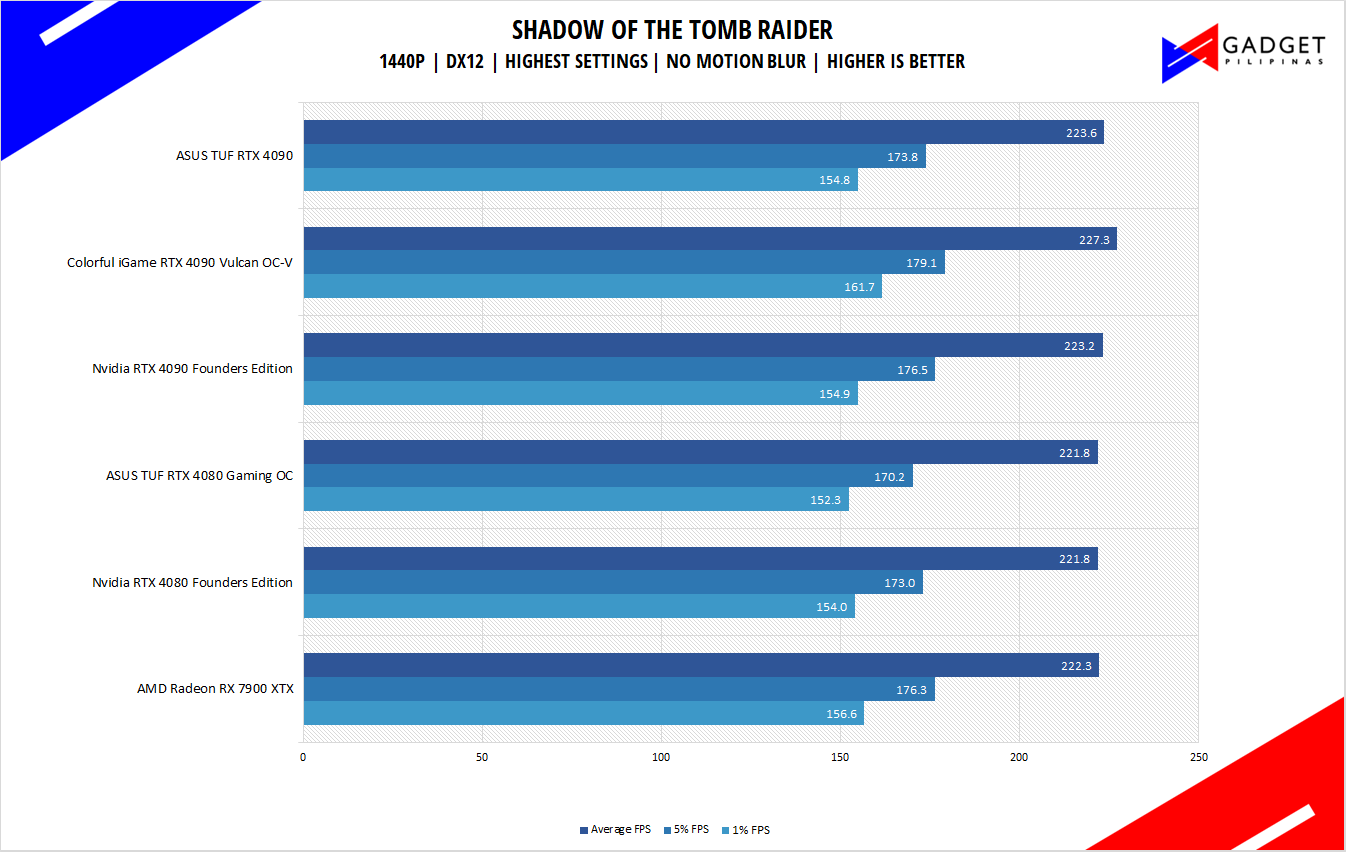
Shadow of The Tomb Raider or SOTR is the latest installment of the Lara Croft Tomb Raider franchise. Developed by Square Enix, SOTR uses the Foundation engine and is further enhanced by Eidos Montreal. SOTR is also one of the first games to come out with Ray Tracing and DLSS support.
Metro Exodus
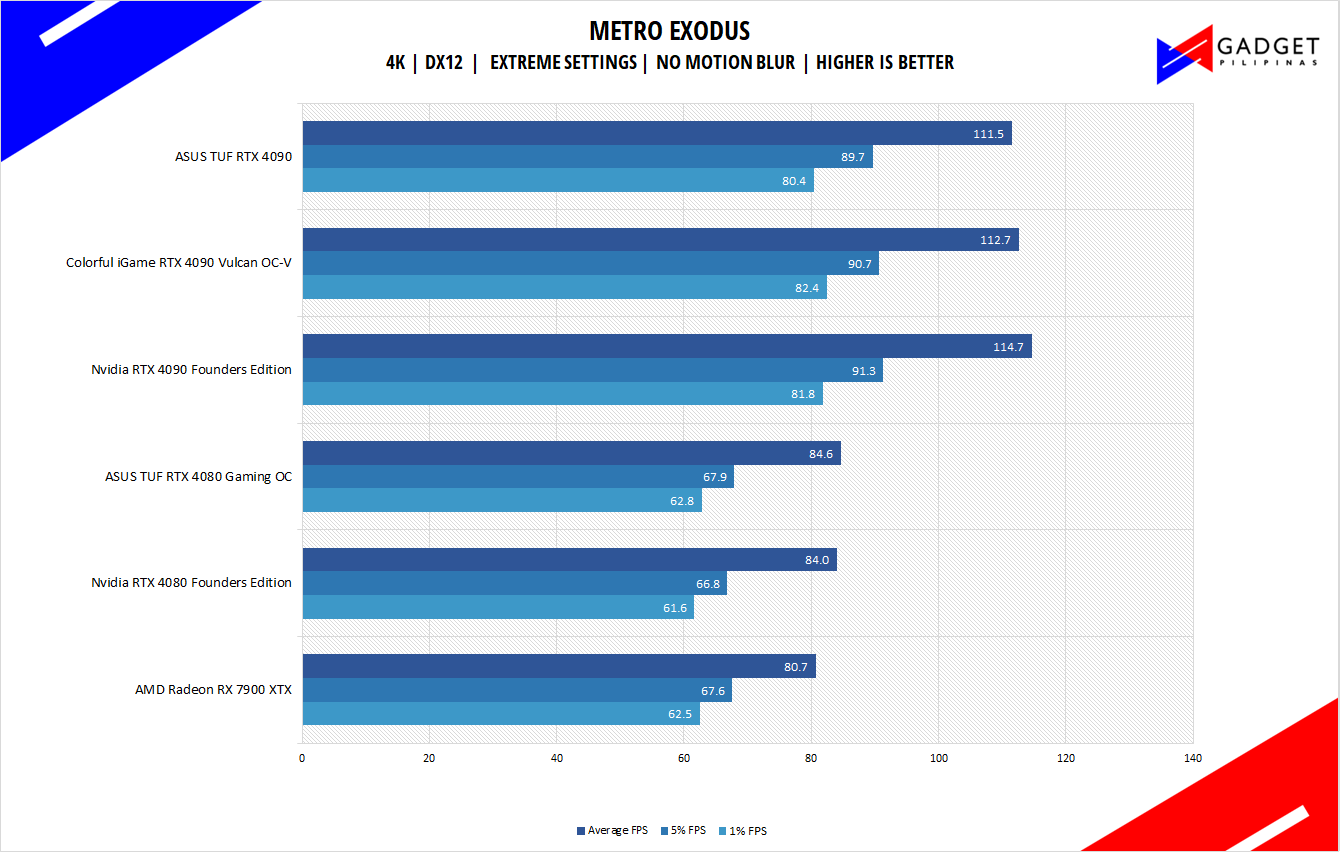
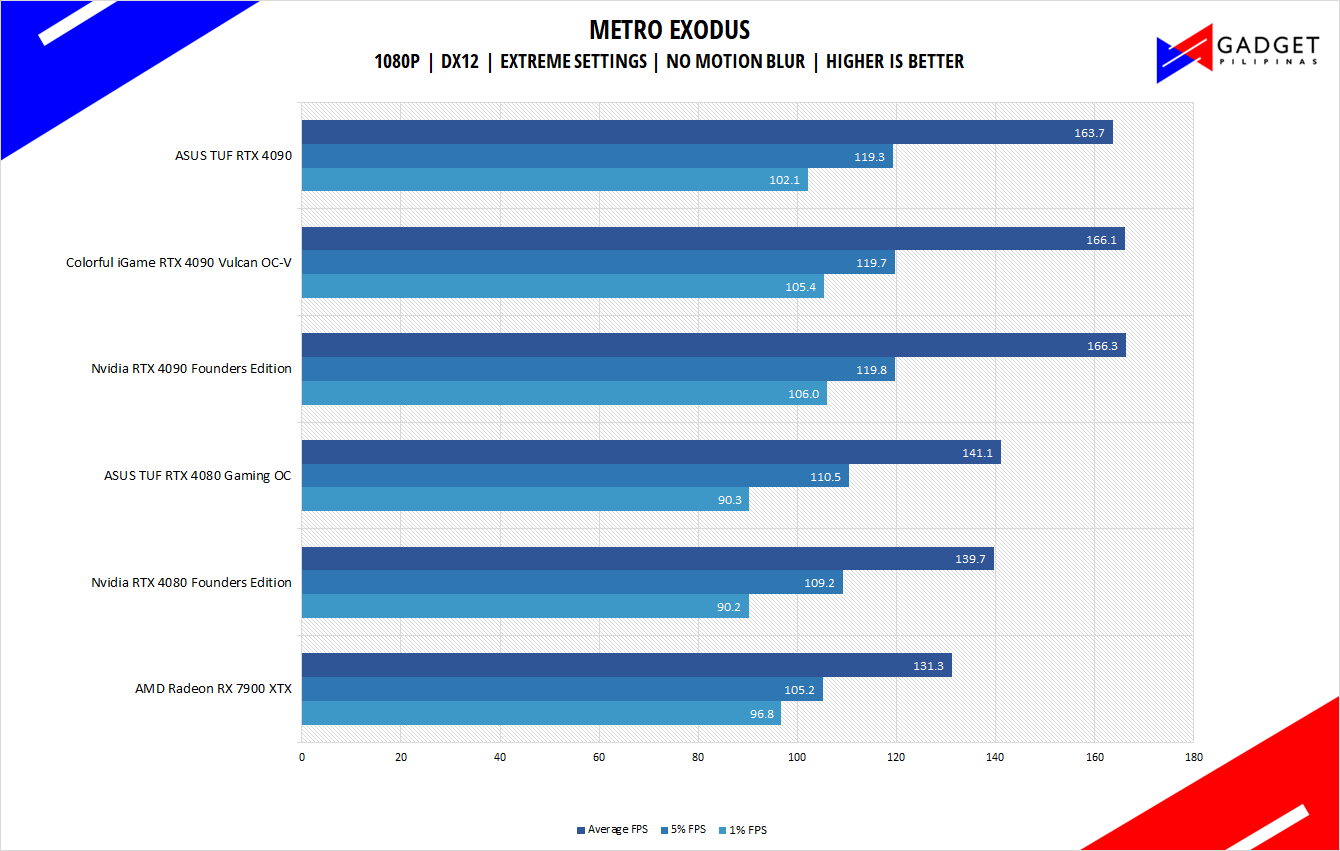
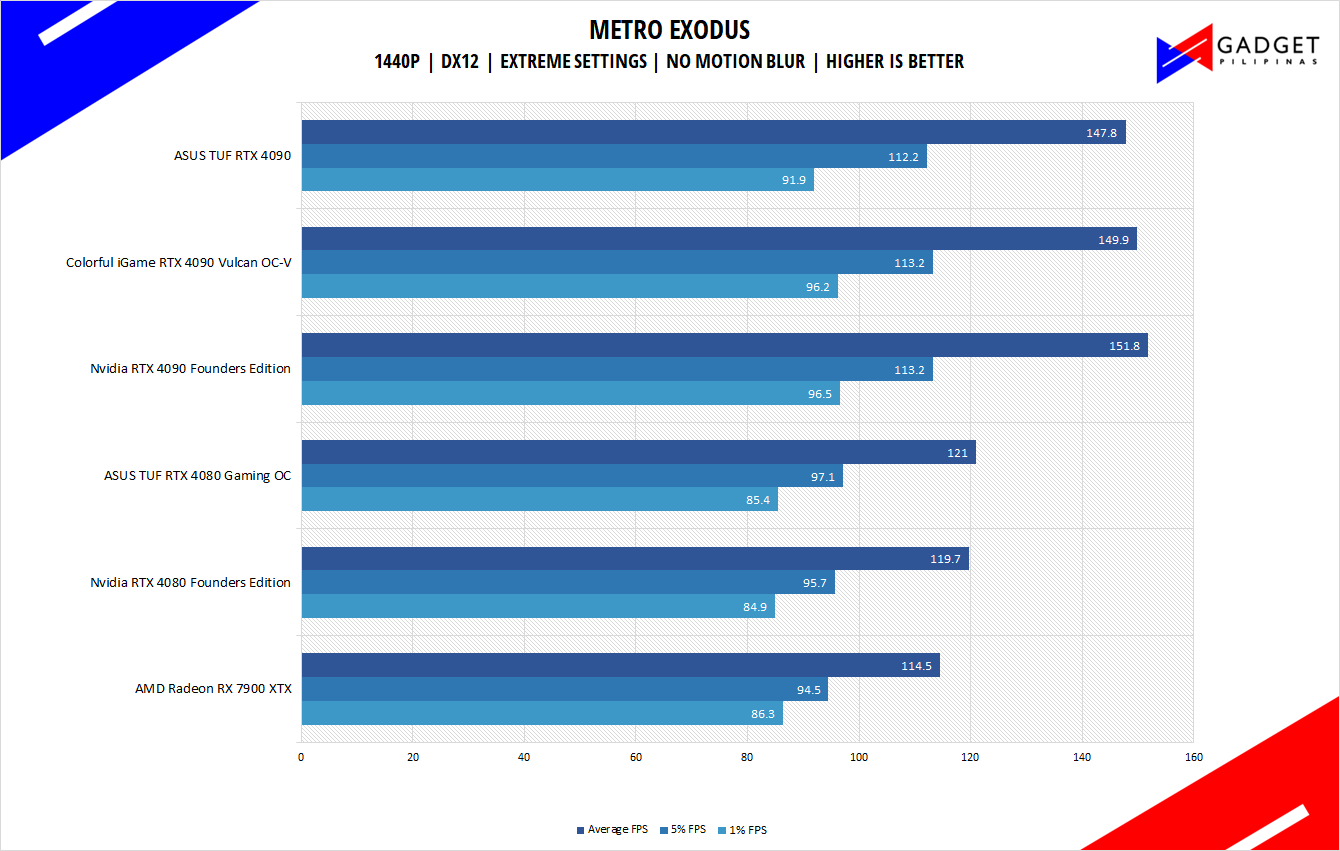
Metro Exodus is the third Metro game trilogy based on Dmitry Glukhovsky’s novels. The game is a first-person shooter with survival horror and stealth elements. The post-apocalyptic game uses 4A Engine by 4A games. Released last 2019, Metro Exodus remains to be one of the most graphically pleasing and demanding games that’s popular to date.
Assassin’s Creed: Odyssey and Valhalla
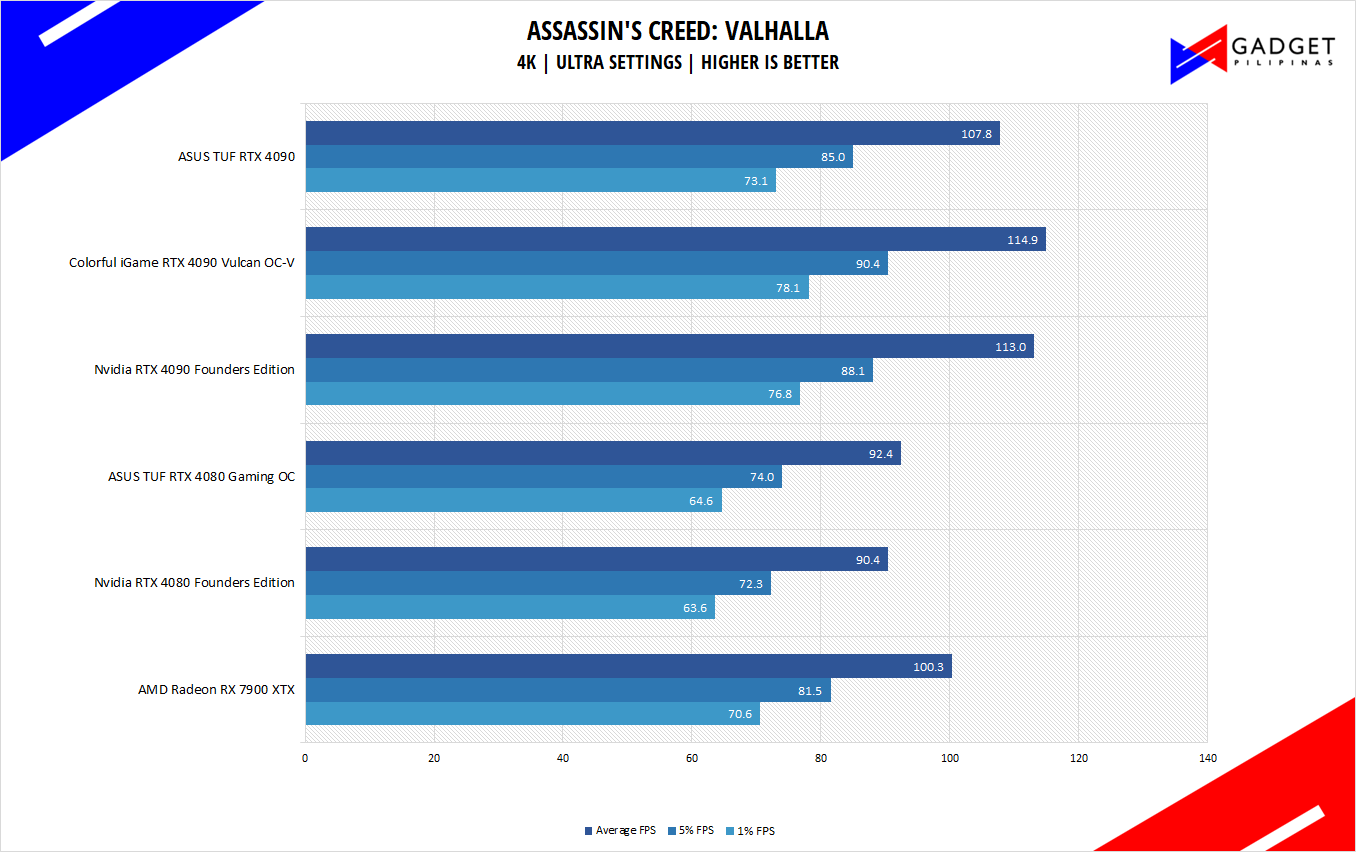
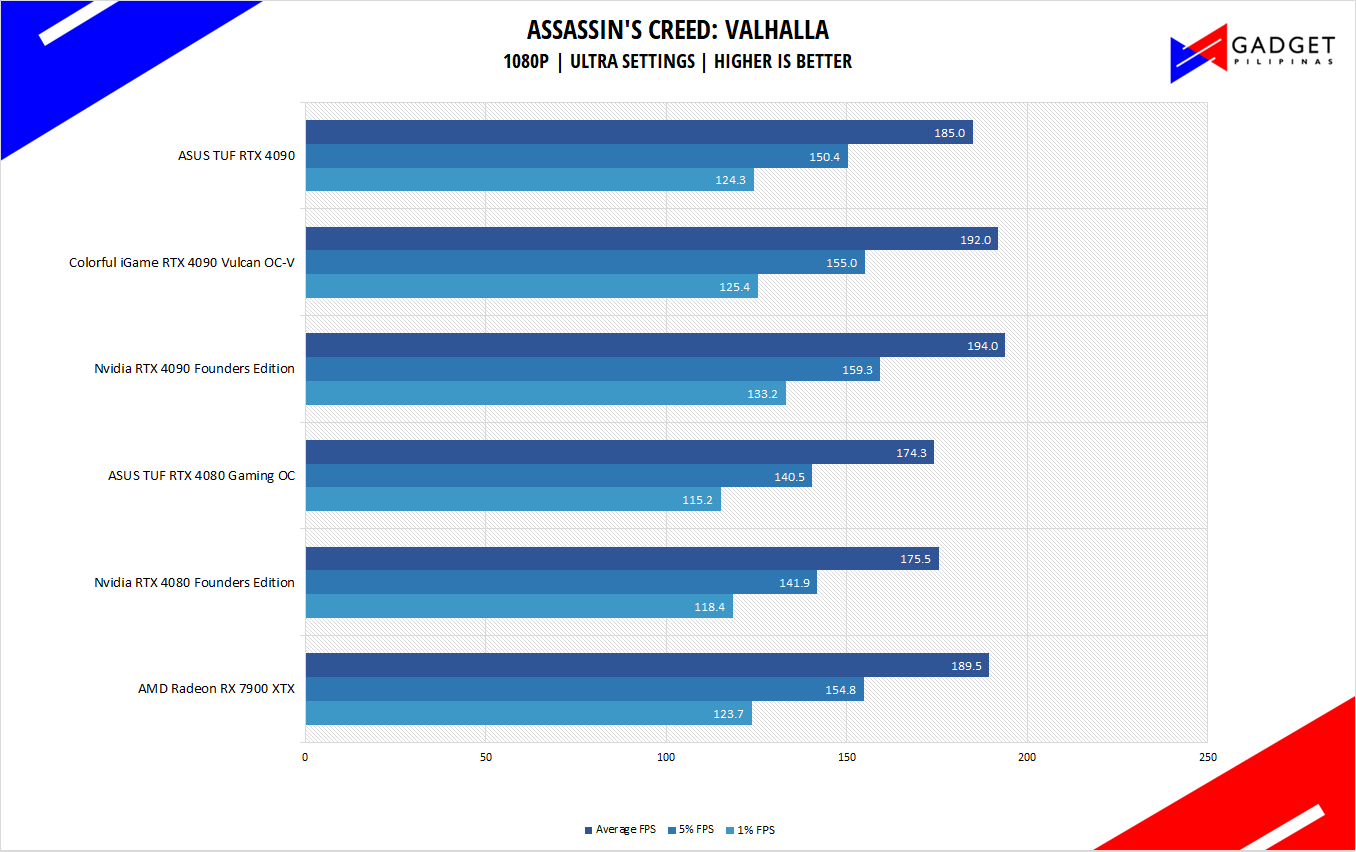
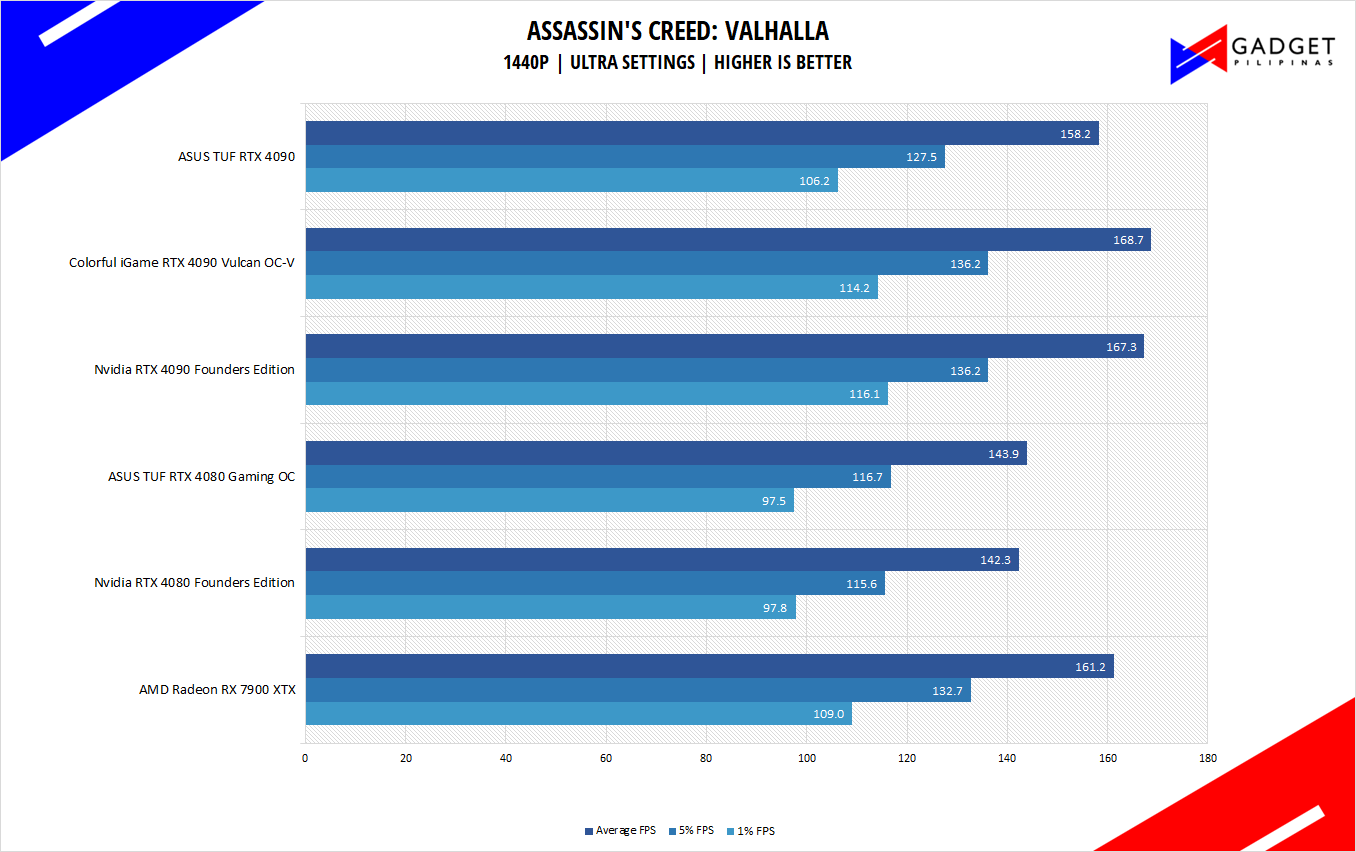
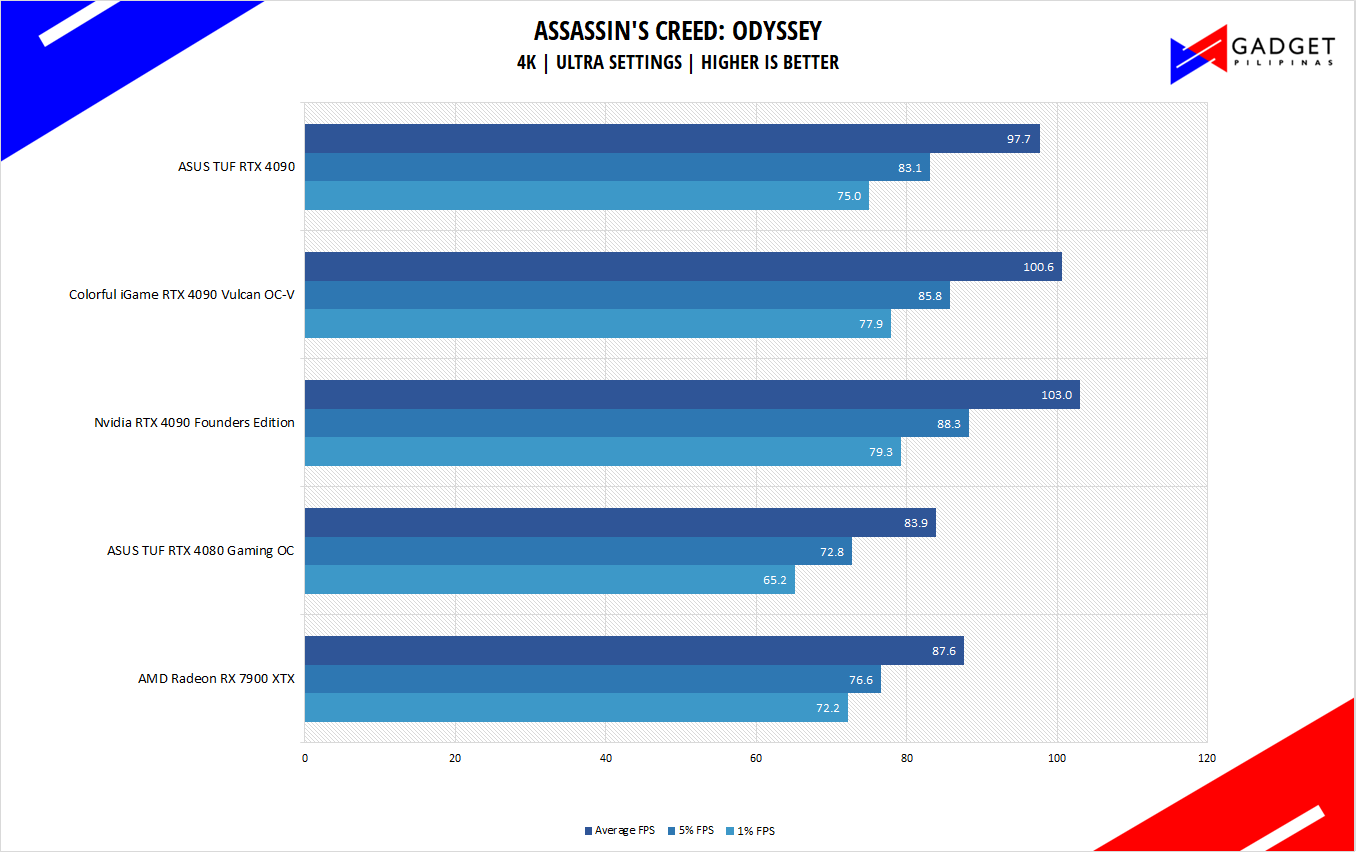
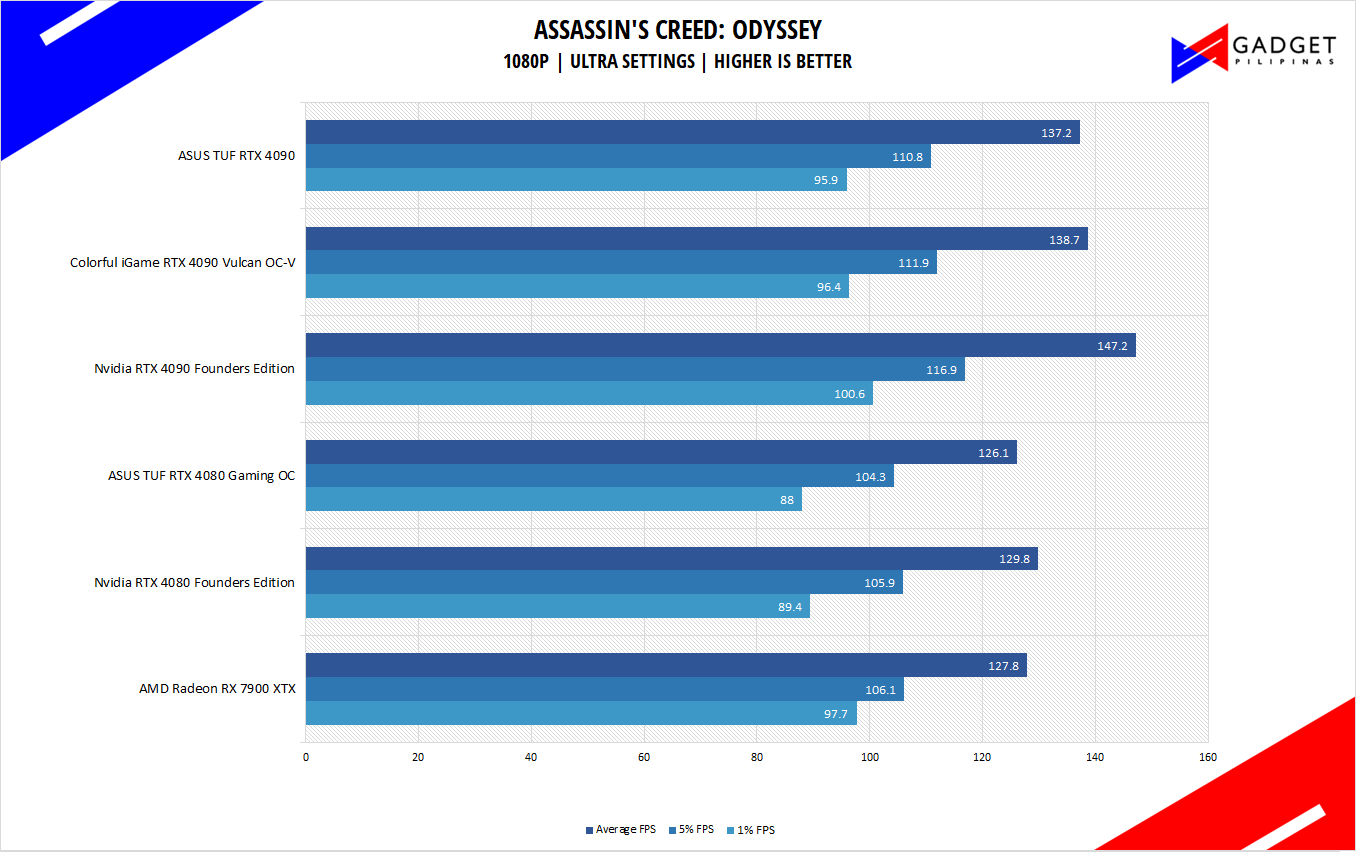
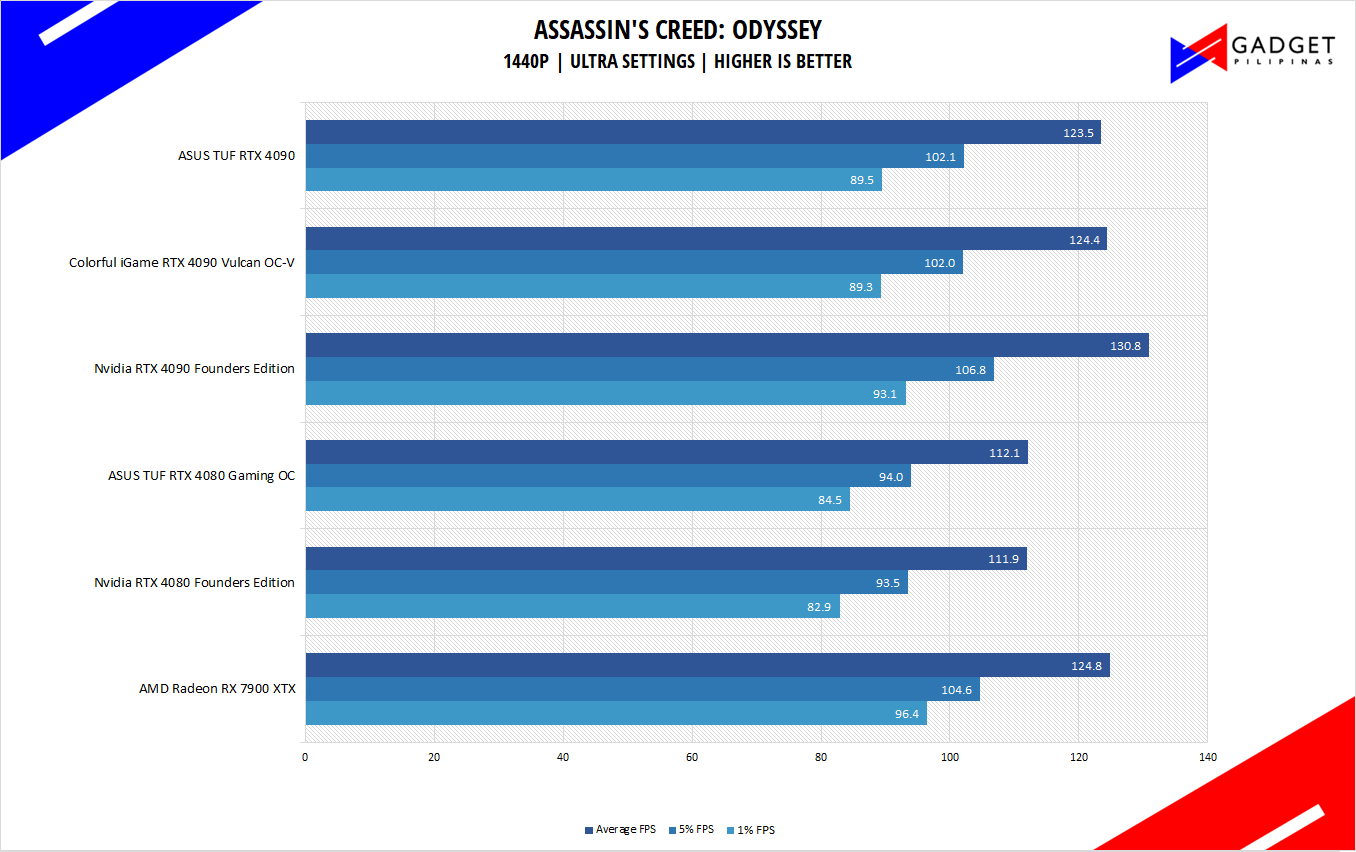
Assassin’s Creed Odyssey is the latest franchise installment from Ubisoft. It’s by far the most popular and stable Assassin’s Creed title since AC IV: Black Flag. It uses the AnvilNext 2.0 game engine, an updated version of Rainbow Six Siege’s game engine, and uses the DirectX 12 API.
F1 2020 and F1 22
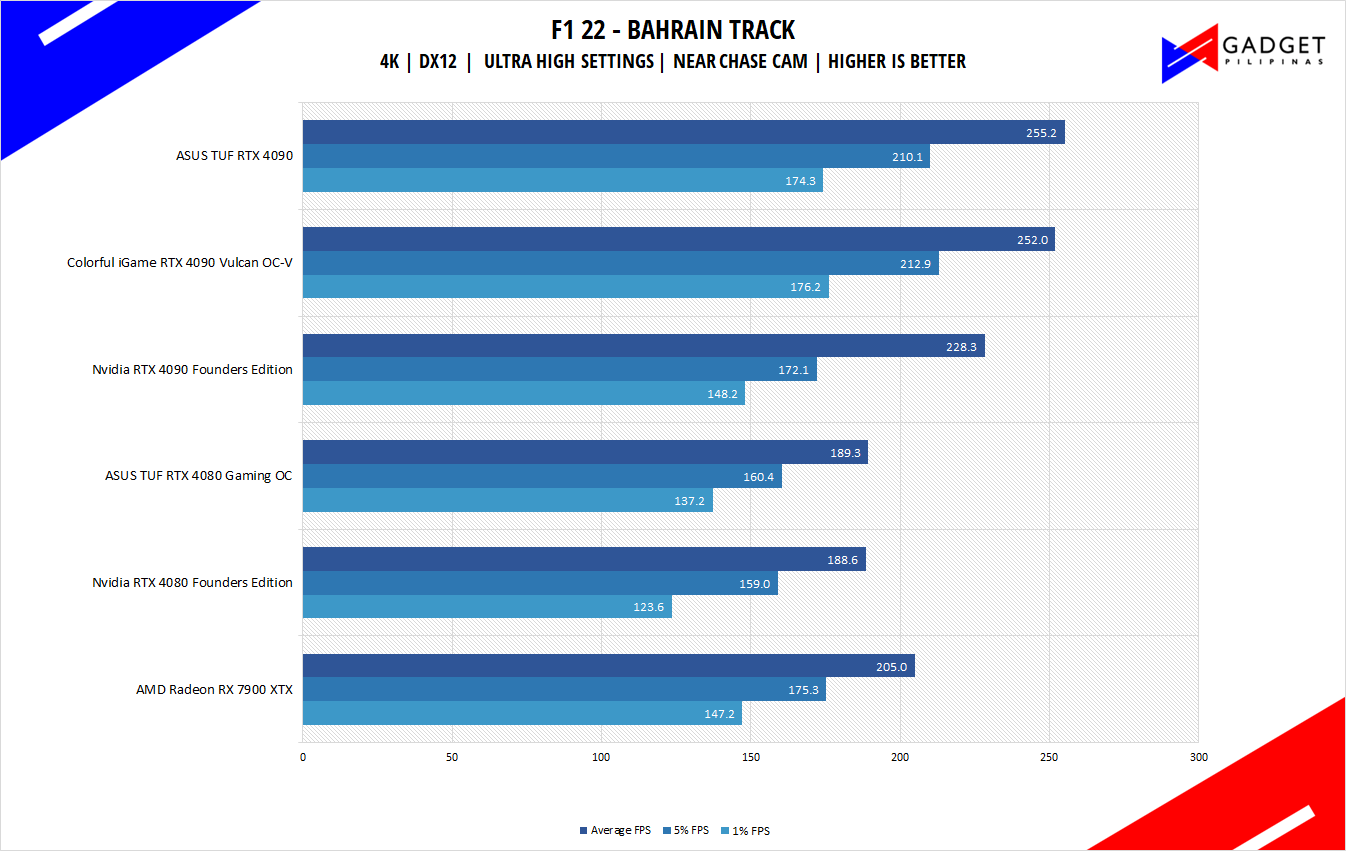
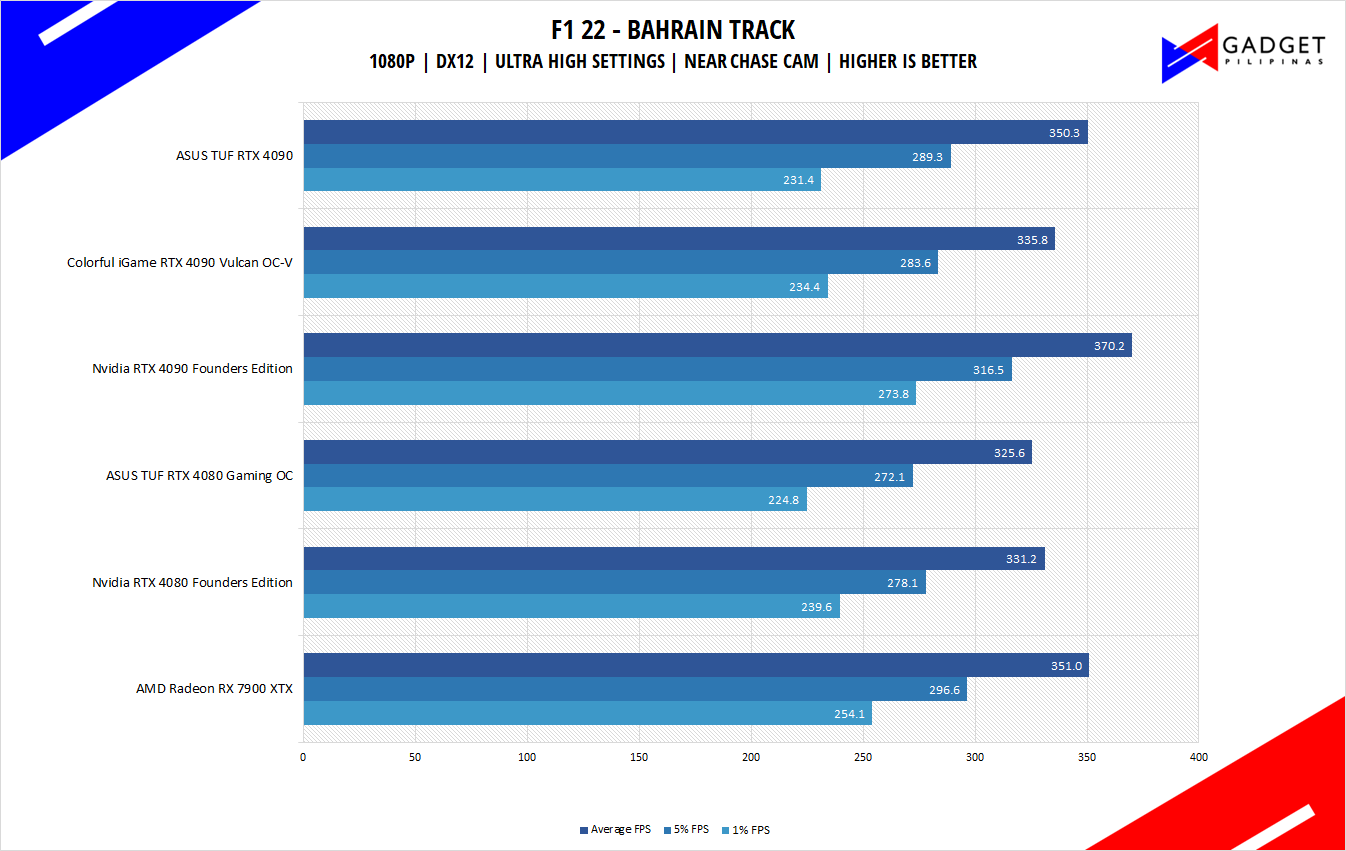
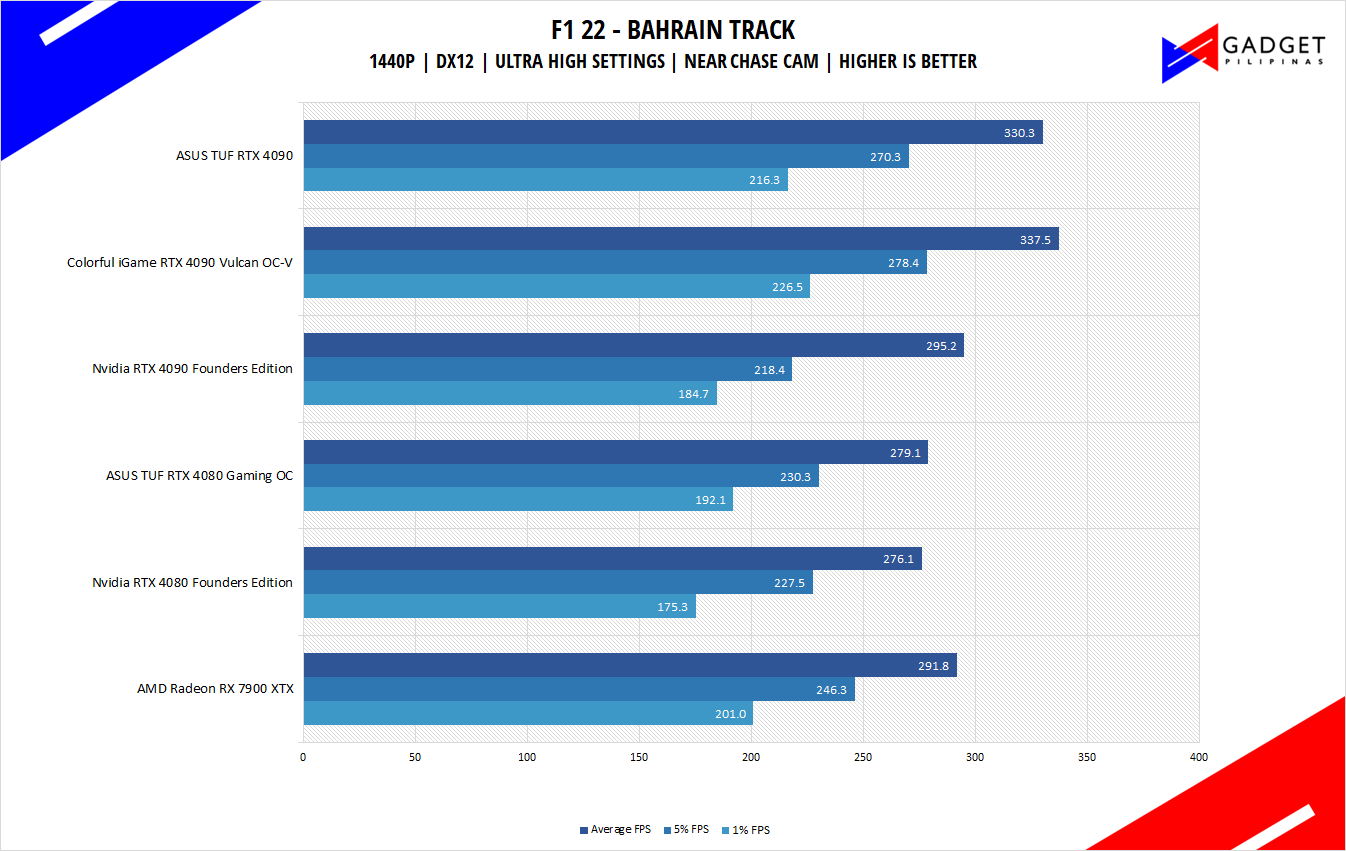
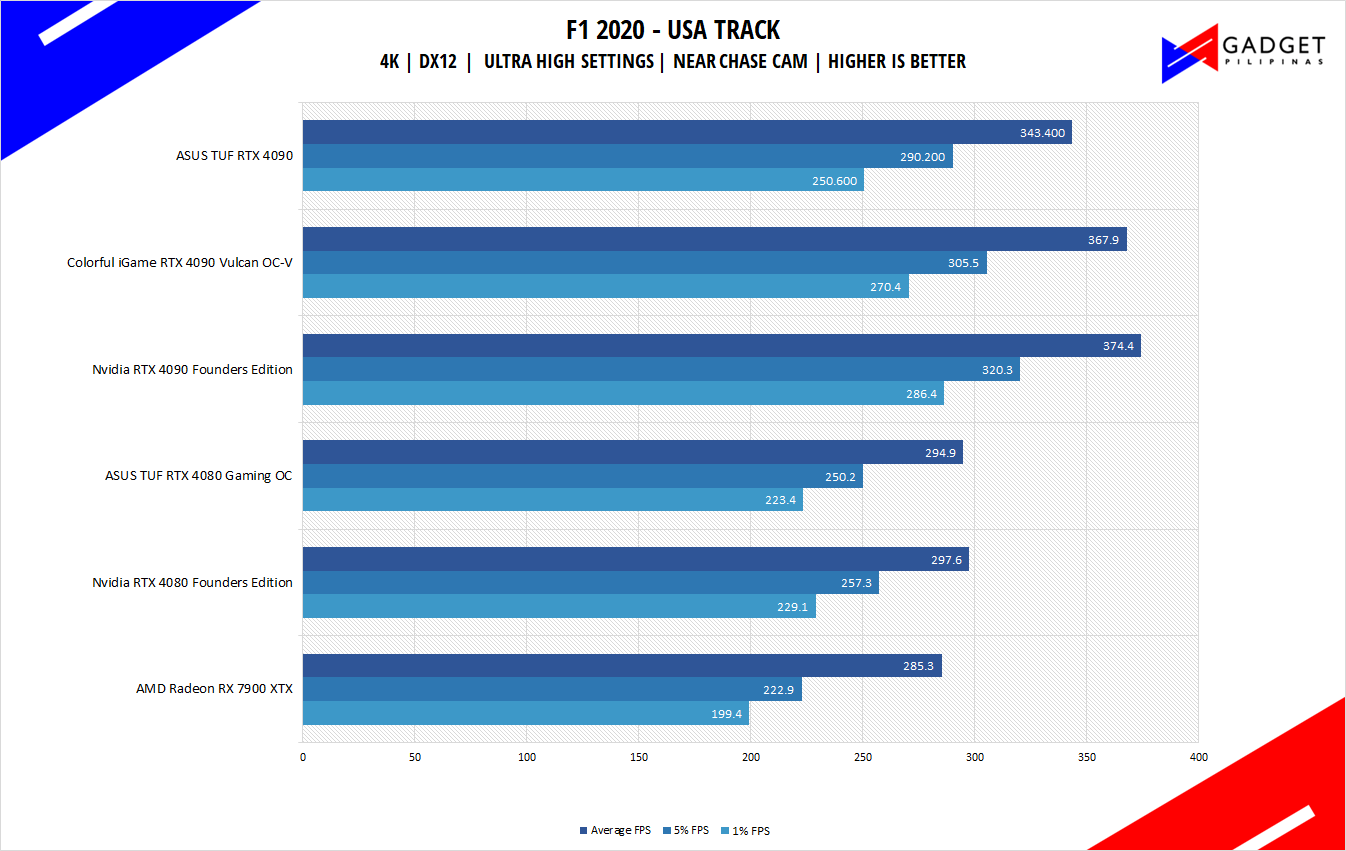
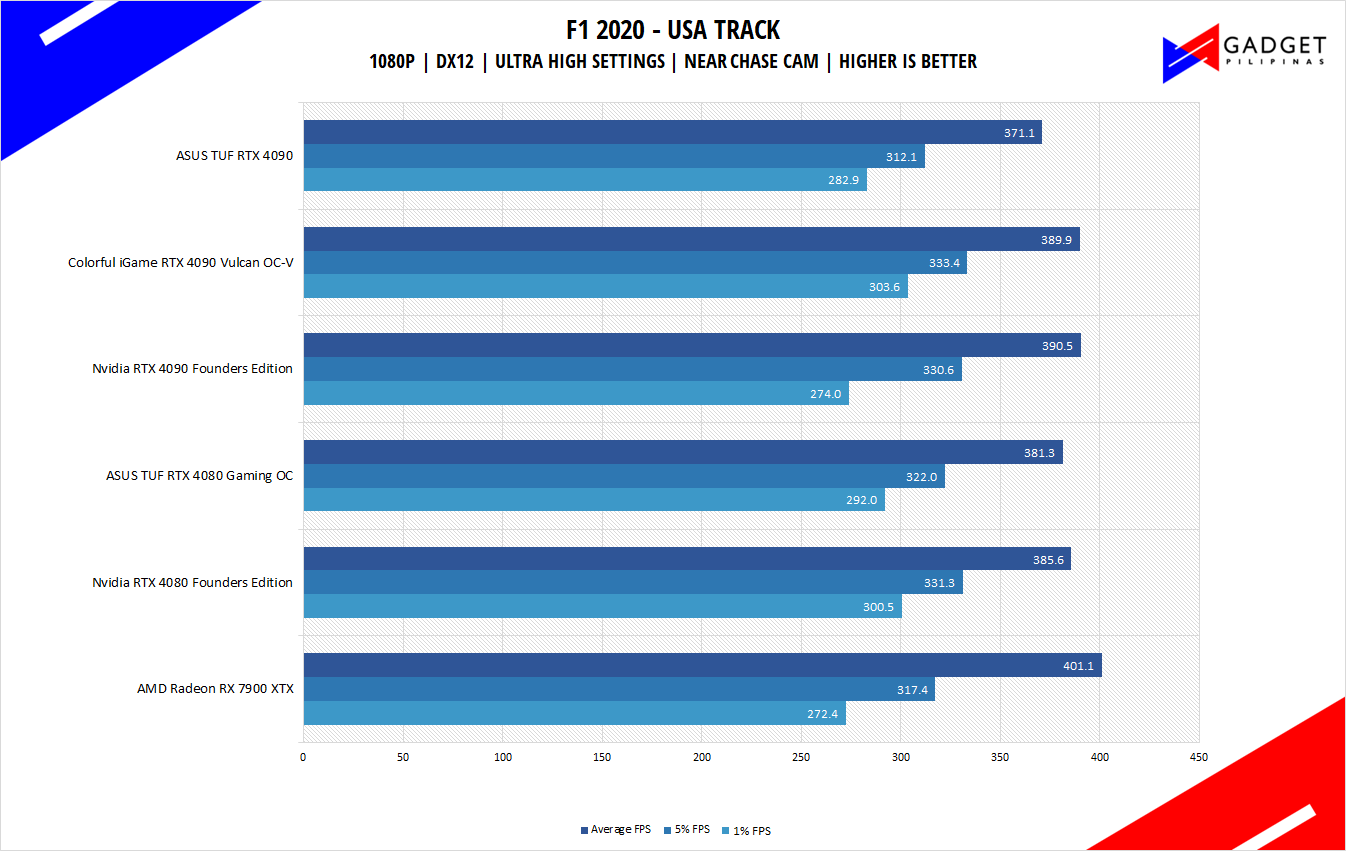
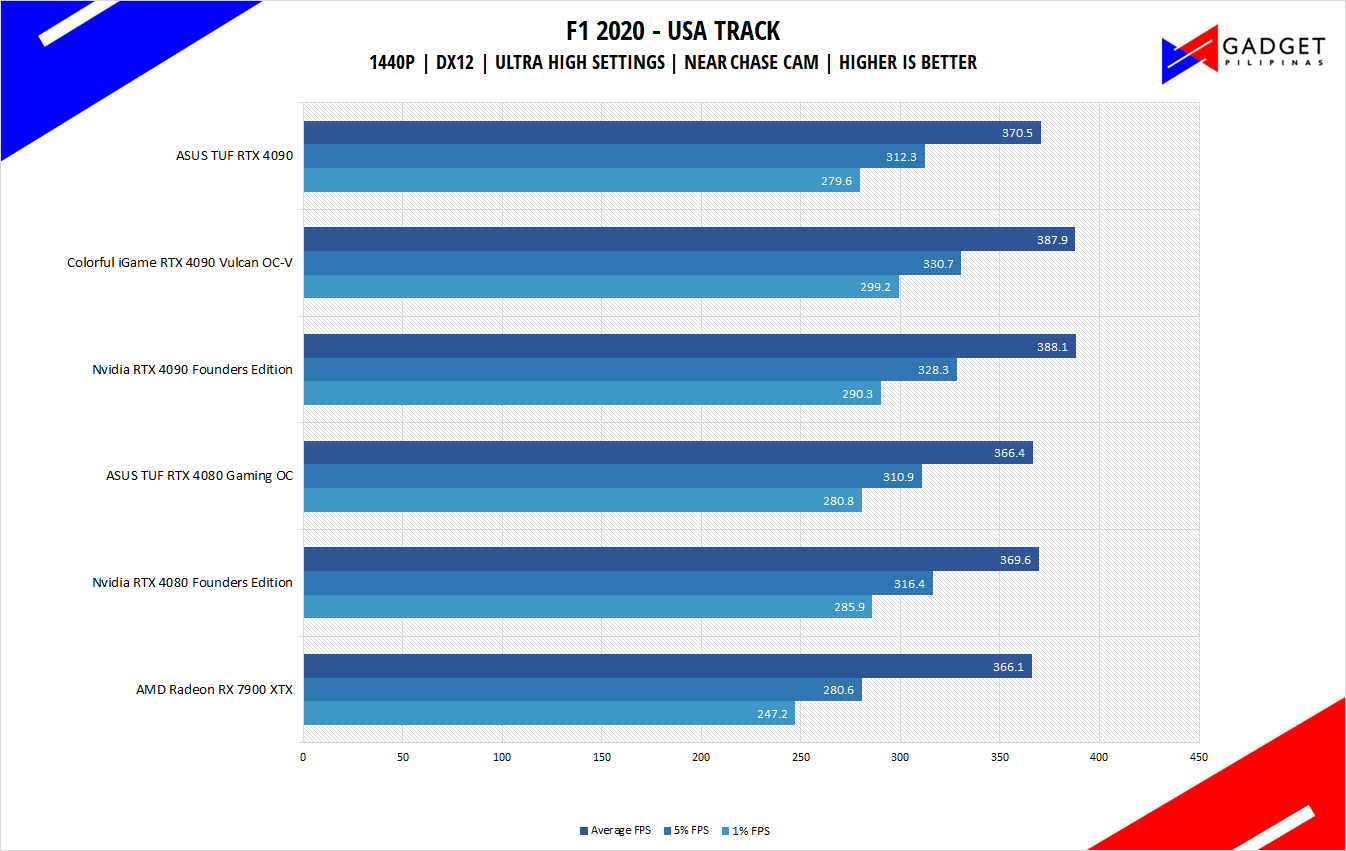
F1 2020 is the official video game of the 2020 Formula 1 and Formula 2 championships developed by Codemasters. F1 2020 is the twelfth installment in the franchise and uses the Ego Engine 3.0. F1 2020 is a good representation of racing games thanks to its realistic graphics and fairly demanding spec requirements.
HORIZON ZERO DAWN
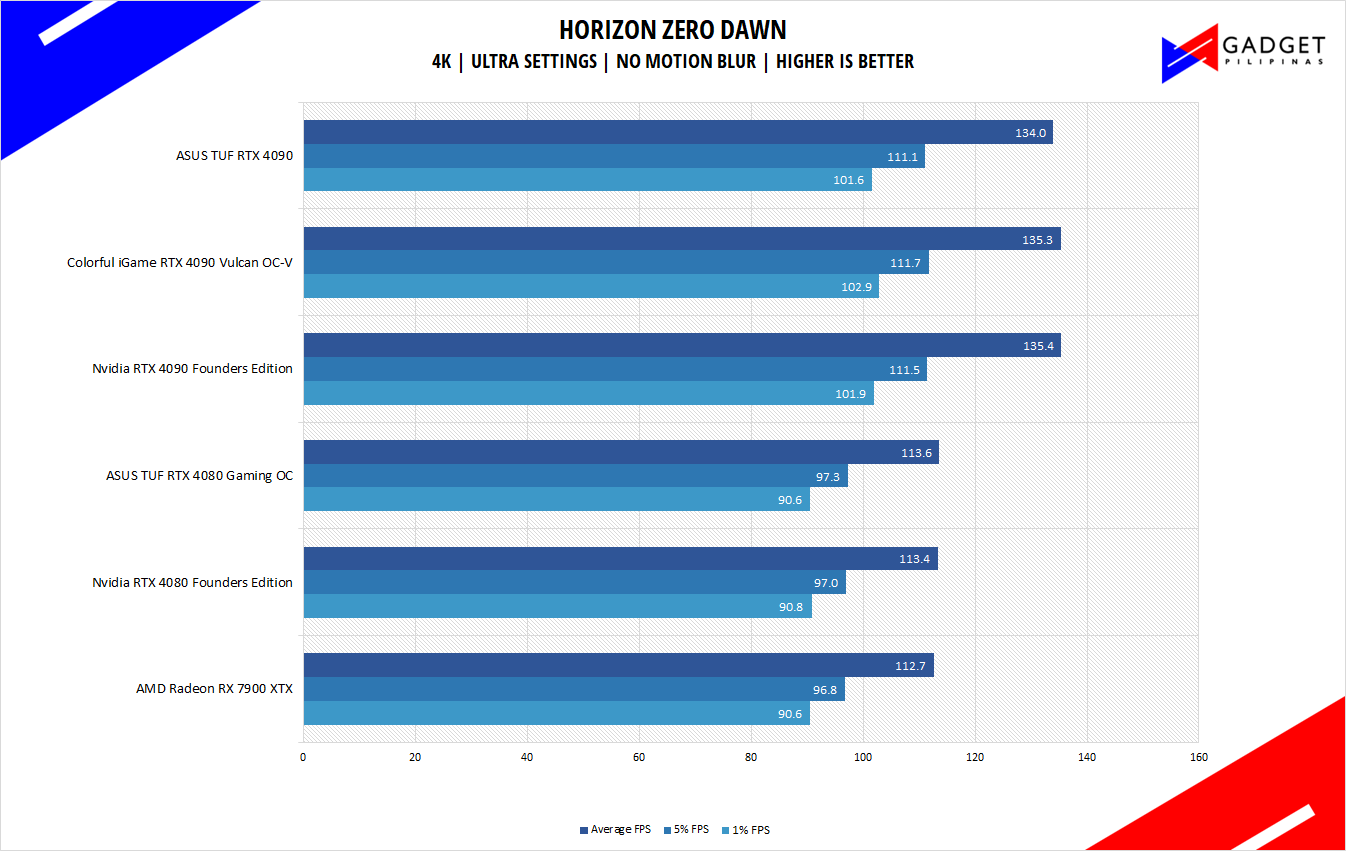
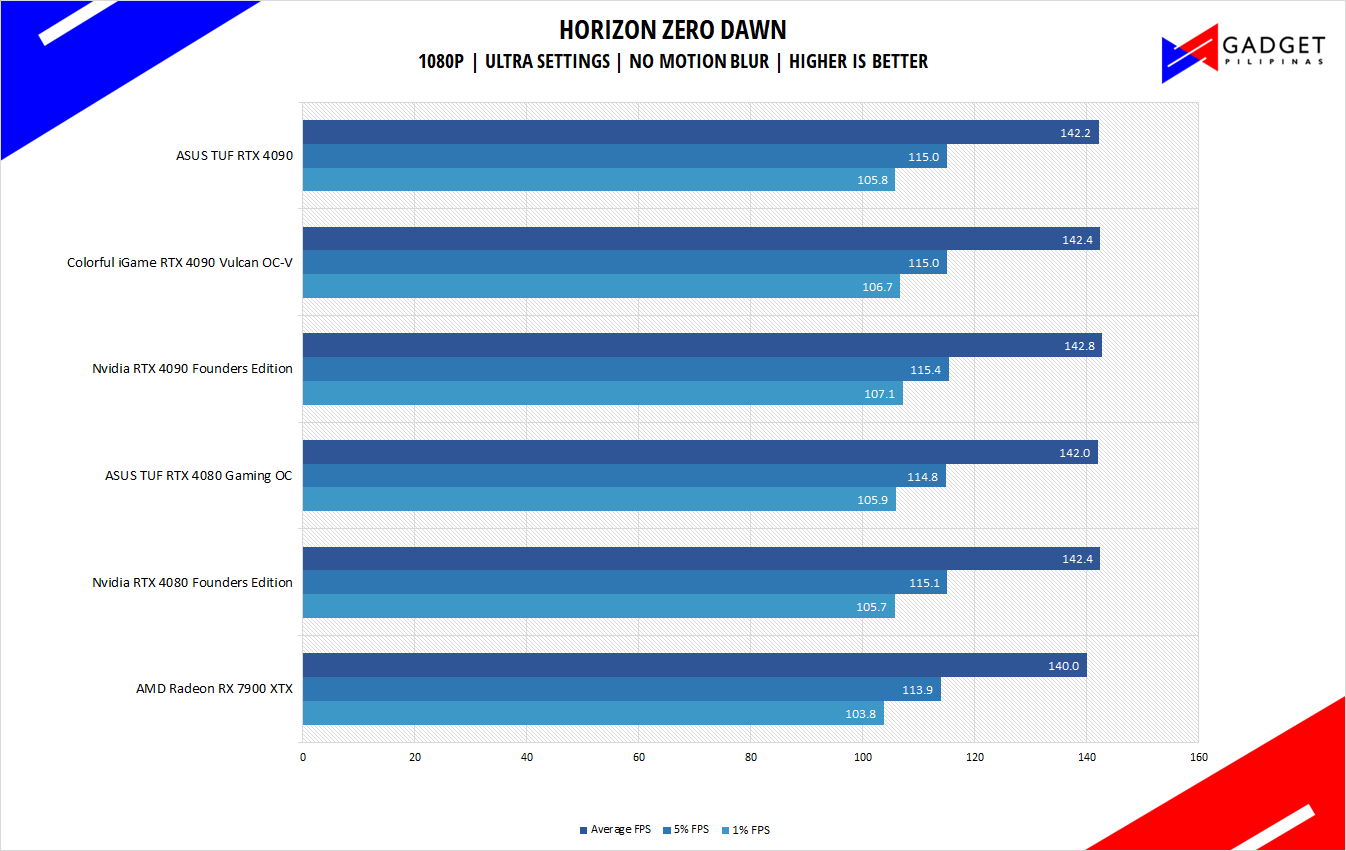
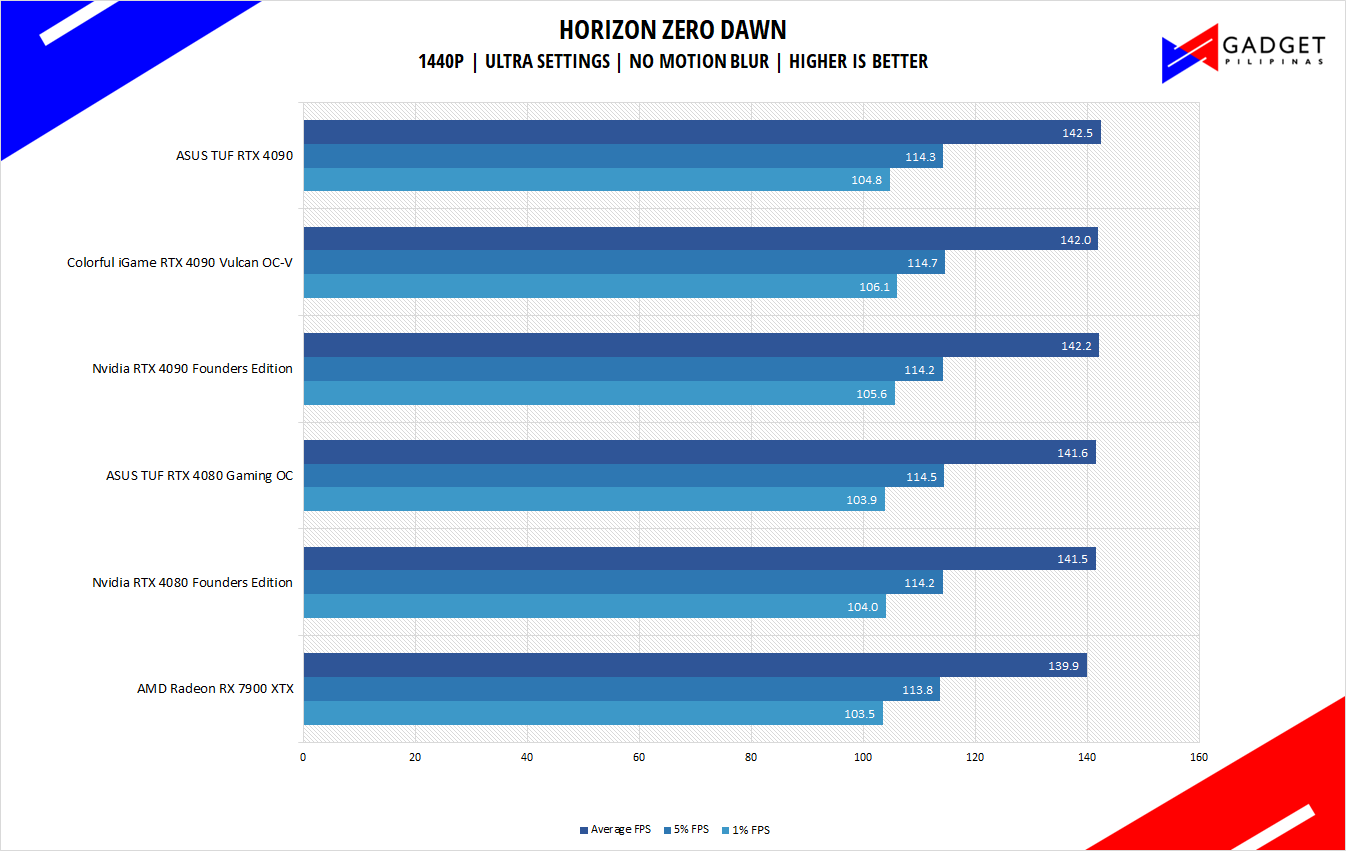
Horizon Zero Dawn is one of the most popular console-port RPG developed by Guerilla Games and published by Sony Interactive Entertainment. Horizon Zero Dawn is a multi-award-winning action RPG, and its popularity resulted in an exclusive Complete Edition game bundle on Steam.AMD Radeon RX 7900 XTX Ray Tracing and Benchmarks
CALL OF DUTY MODERN WARFARE II
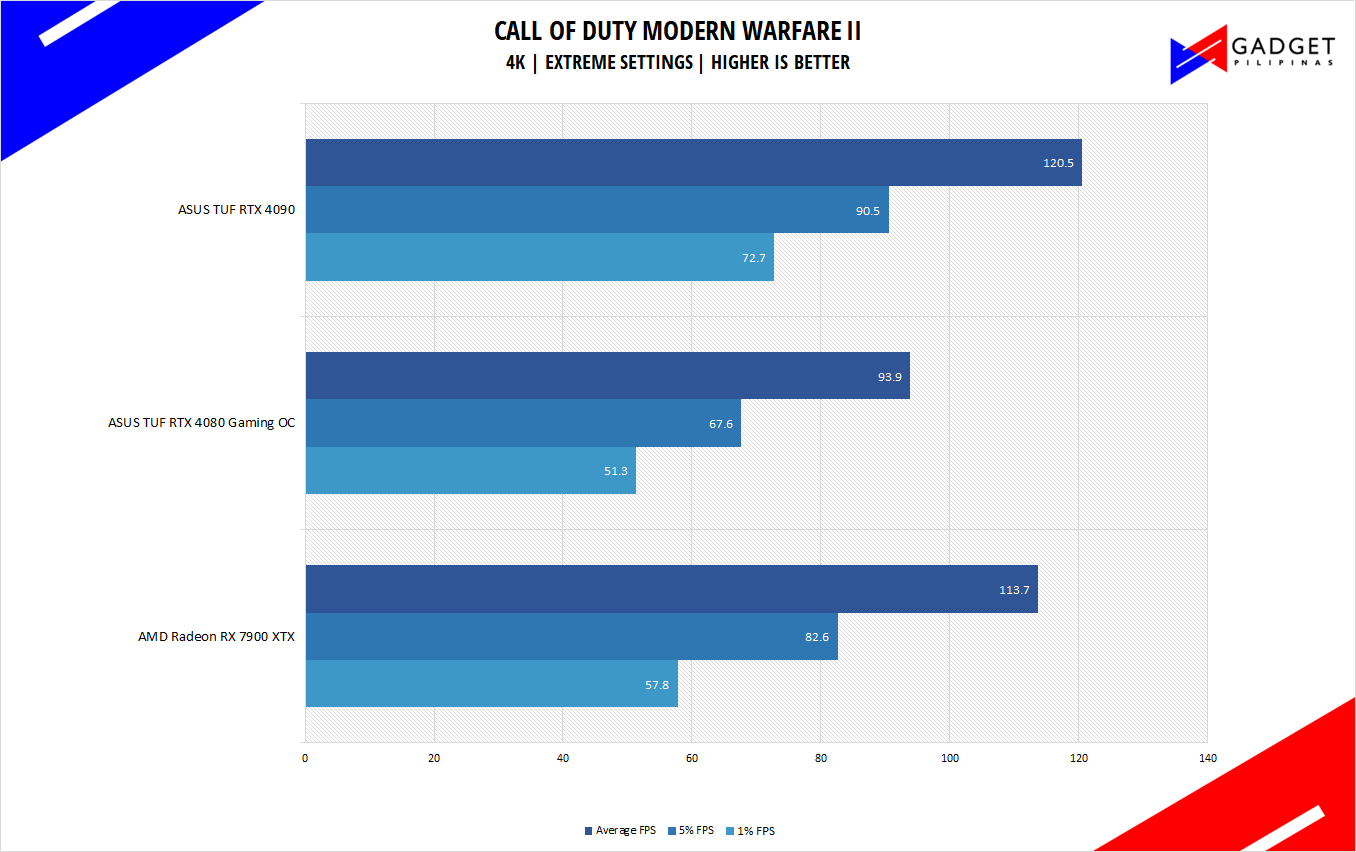
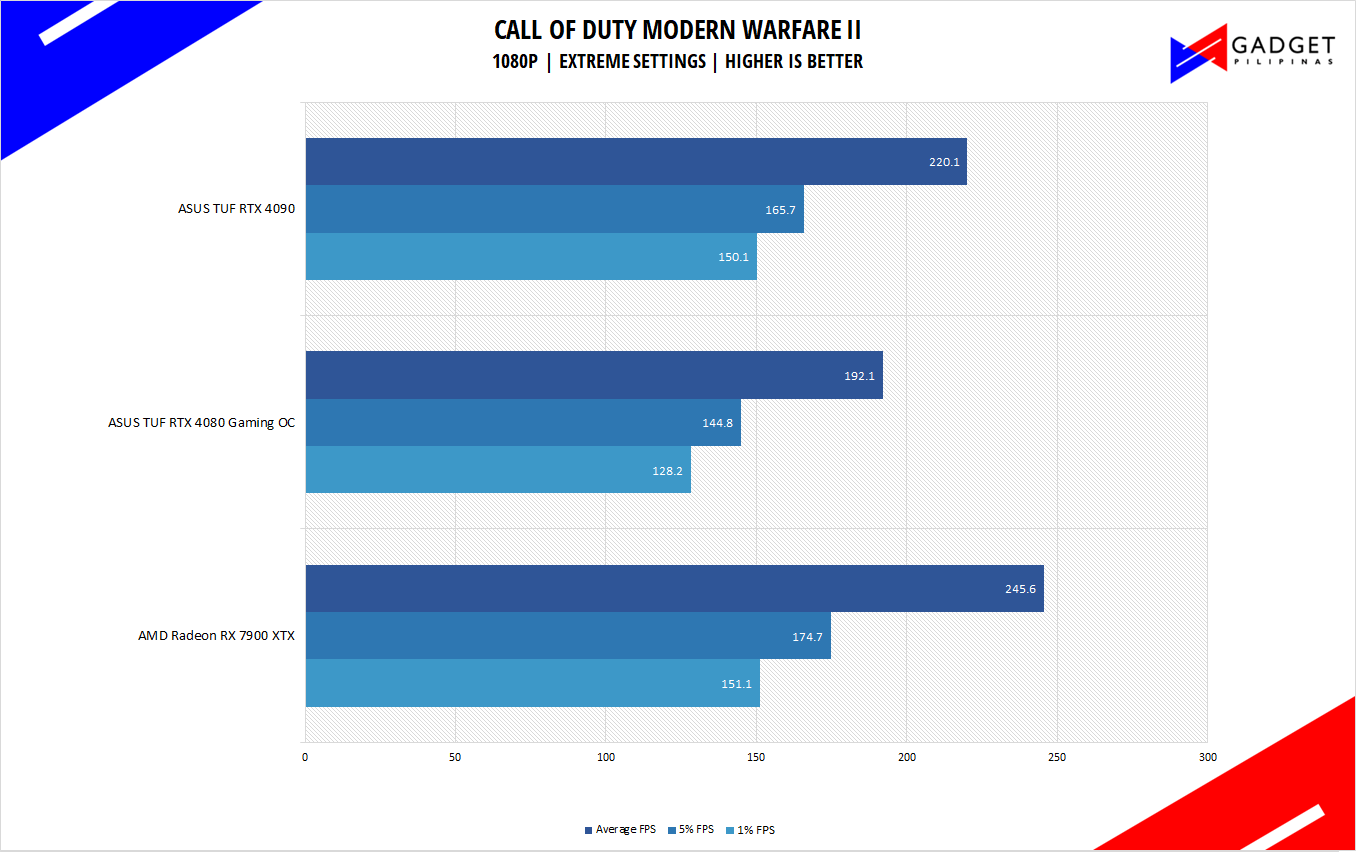
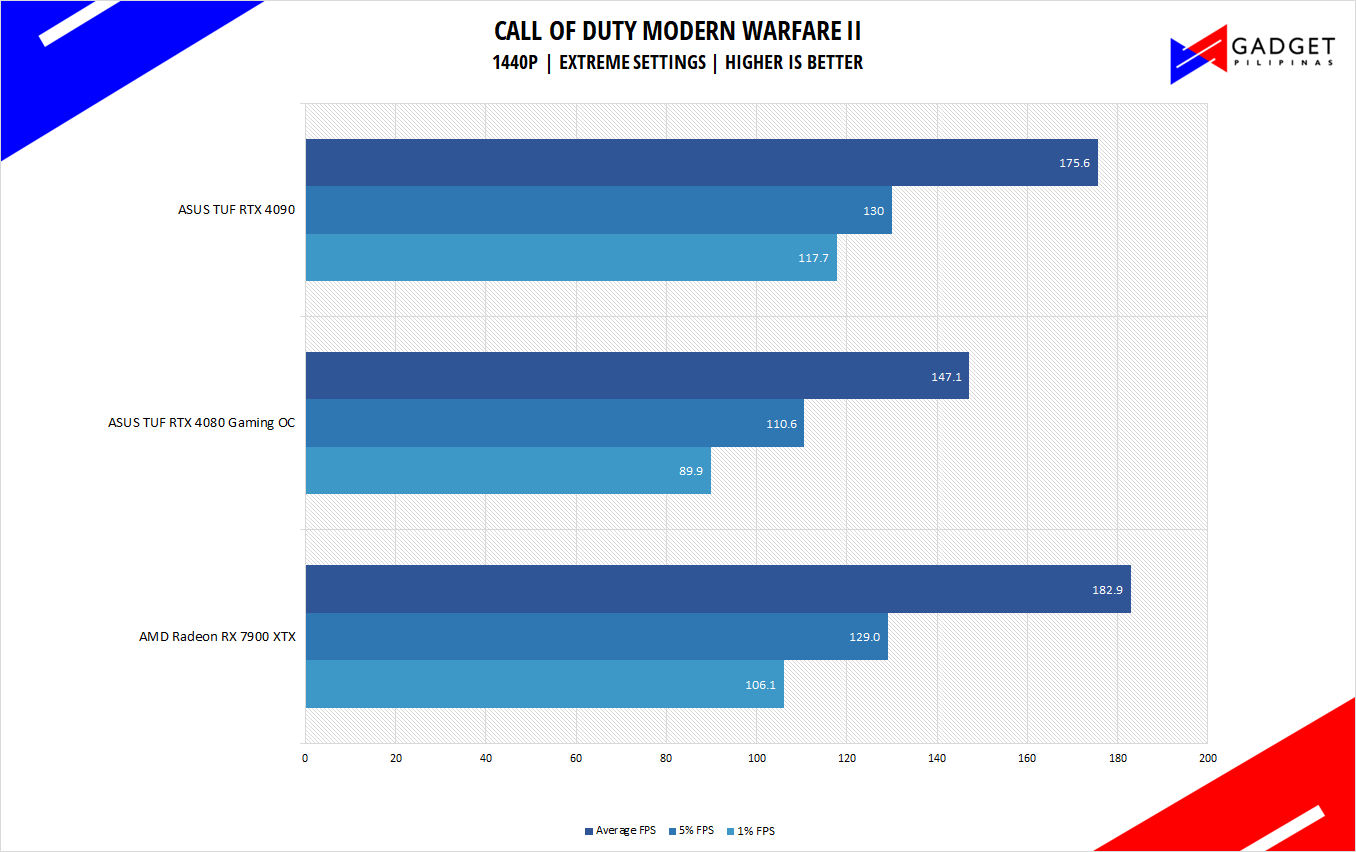
AMD Radeon RX 7900 XTX Temperatures and Power Daw
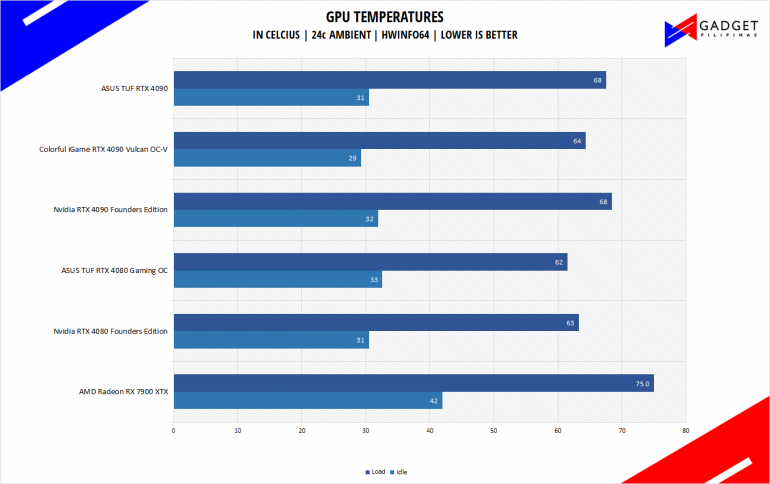
Temperatures on the RX 7900 XTX are somewhat expected considering its compact form factor with a max recorded temp of 75°C, the highest across our benchmark suite. It also has a higher idle temp at 42°C due to its smaller heatsink volume because of its form factor. Overall, the 75°C peak temp isn’t too hot, especially considering the previous generation AMD RX 6800 XT peaked at 90°C.
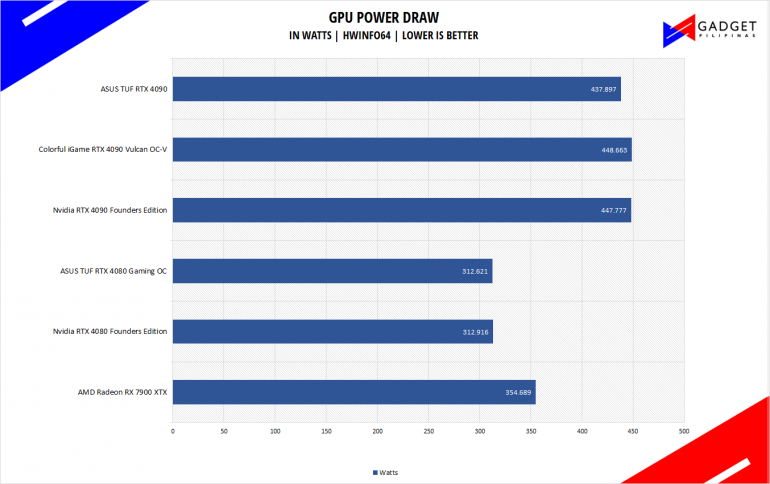
Power-consumption-wise, the RX 7900 XTX is expected to have higher power consumption due to it having a larger process node and more memory compared to the RTX 4080.
Performance Summary and Conclusion
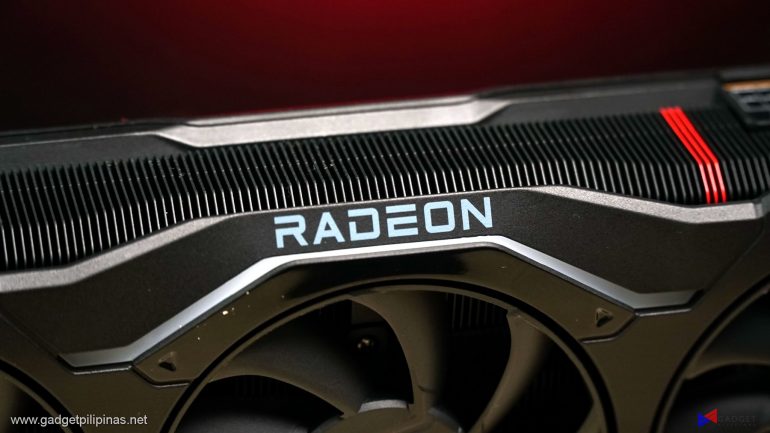
AMD proudly delivers its claims with the Radeon RX 7900 XTX providing impressive results in our benchmark suite. It doesn’t have a total, crushing win over the RTX 4080 but it does have higher margins when it wins against Nvidia’s offering. Its price of $999 US greatly undercuts the RTX 4080 with its superb performance at the expense of slightly higher power consumption and of course, lower framerates in Ray Tracing especially even when DLSS and FSR are enabled.
Overall, the Radeon RX 7900 XTX is a great alternative, heck, is a much more compelling option than the RTX 4080 depending on how you look at it aka your needs as a gamer. If you care about only rasterization performance aka non-raytraced titles, Radeon RX 7900 XTX is a no-brainer purchase as you’re saving $200 is basically the Ray Tracing Premium that the RTX 4080 has. That said, when Ray Tracing and performance upscaling technology are taken into account, the RTX 4080 has the edge.
In the Philippine market(which can also apply to countries outside the US), the RX 7900 XTX has an SRP of 71,000 while the RTX 4080 has a price of Php 84,000 which is a far greater spread than $200 converted. Taking that into consideration, the RX 7900 XTX has insane value for the performance and features that it offers. So, if you’re in the market for a flagship-level graphics card without the extra associated cost ie PSU upgrades, and without shelling out too much like the RTX 4090, then the AMD Radeon RX 7900 XTX is a must-have for gamers wanting to have the best bang for their buck.
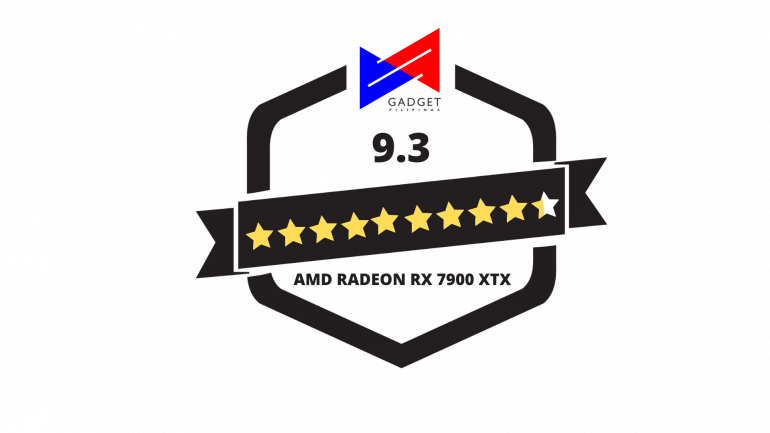
Grant is a Financial Management graduate from UST. His passion for gadgets and tech crossed him over in the industry where he could apply his knowledge as an enthusiast and in-depth analytic skills as a Finance Major. His passion allows him to earn at the same time help Gadget Pilipinas' readers in making smart, value-based decisions and purchases with his reviews and guides.

